
- English Essays Grade 2
- English Essays Grade 3
- English Essays Grade 4
- English Essays Grade 5
- English Essays Grade 6
- English Essays Grade 7
- Sinhala Essays (සිංහල රචනා ) Grade 2
- Sinhala Essays (සිංහල රචනා ) Grade 3
- Sinhala Essays (සිංහල රචනා ) Grade 4
- Sinhala Essays (සිංහල රචනා ) Grade 5
- Sinhala Essays (සිංහල රචනා ) Grade 6
- Sinhala Essays (සිංහල රචනා ) Grade 7
- Sinhala Alphabet
- English Stories
- Sinhala Stories
- Videos Fun and Learning
- Remote Control (RC)
- Sinhala Baby names for Boys and Girls | බබාට නමක් | පුතාට |දුවට
Select Page

KANDY PERAHERA
- Essays English Grade 4
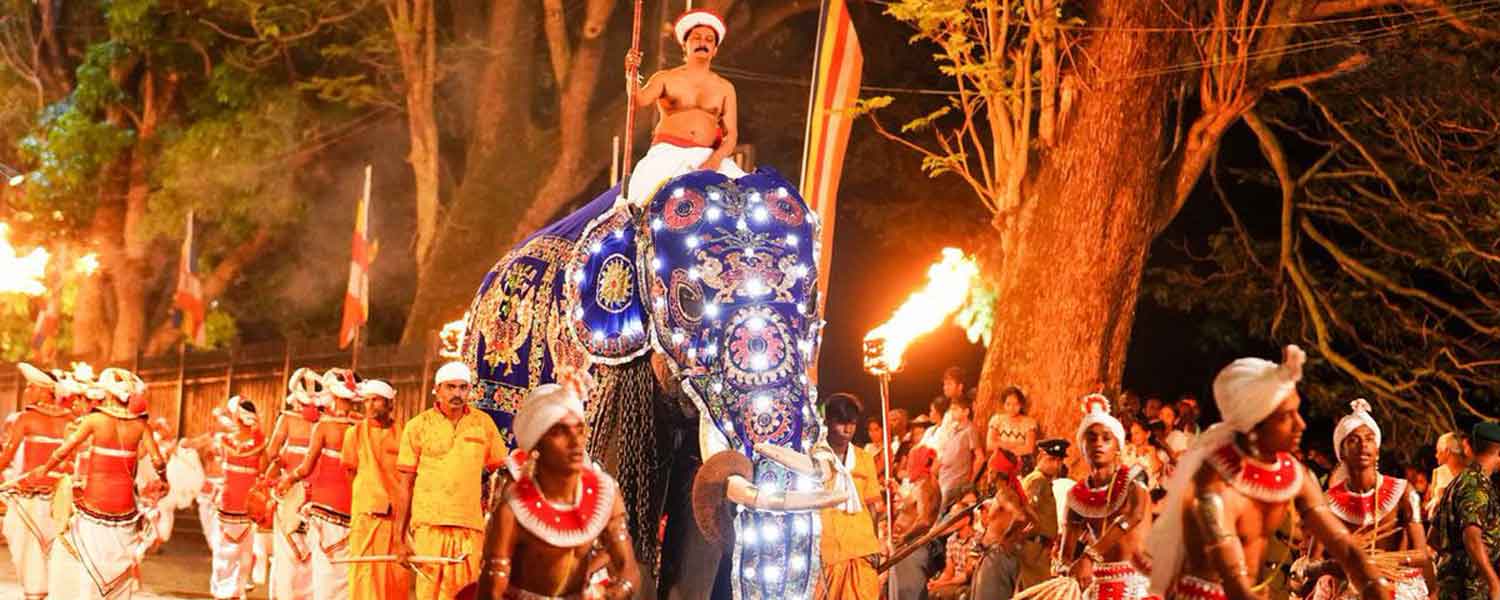
Kandy Perahera English essay
Kandy Perahera comes in March. It is very interesting. A lot of people visit Kandy to see the Perahera. Many elephants walk in the Perahera. ‘The Maligawa elephant’ is the most beautiful.
It takes the casket of tooth -the tooth of Lord Buddha. The Kandyan dancers go in front. Elephants come after them. People watch the Perahera and they feel happy. It is a colourful festival.
100 % FREE ENGLISH ESSAYS FOR GRADE 4
English essays for Grade 2 (Class 2) , Grade 3 (Class 3), Grade 4 (Class 4), Grade 5 (Class 5), Grade 6 (Class 6), Grade 7 (Class 7)
We are excited to announce that we are working with more new features to guide parents and students on essay writing.
Writing is one of the essential skills for your child’s education. Unfortunately, classroom settings frequently don’t give sufficient practice time to sharpen those writing abilities truly. So we are preparing simple and important guidelines to teach essay writing to your children at home and hope to publish as soon as possible.
OTHER USEFUL LINKS
The national e-learning portal for the general education.
The e-thaksalawa is made up of resources developed straightened to grade 1 to 13 syllabus materials such as creative lessons, all learning resources including past papers, term papers, questions, syllabuses, textbooks, teacher instructional manuals in Sinhala Tamil and English.
How useful was this Essay / Post?
Click on a star to rate it!
Average rating 3.2 / 5. Vote count: 23
No votes so far! Be the first to rate this post.
We are sorry that this post was not useful for you!
Let us improve this post!
Tell us how we can improve this post?

Fun Learning for preschoolers and kids

WHAT DO I DO EVERY MORNING
I Do Every Morning English essay I get up at 6. I clean my teeth and wash my face. Then I pray to God. I have my tea...

OUR SCHOOL SPORTS MEET
Our School Sport Meet English essay We have our sports meet every May. It is a great day. We have races; 100 meters,...

OUR CLASS TEACHER
Our Class Teacher English essay Miss Suvini Nihara is our class teacher. She is a fair, tall, thin lady. She has a...

My Aunty English essay My aunty’s name is Duleesha. She has long wavy hair and a fine ponytail. She is a slim young...
FLYING KITES

Recent Posts
- Sinhala Baby names for Girls |දුවට නමක් | ඔ
- Sinhala Baby names for Girls |දුවට නමක් | උ
- Sinhala Baby names for Girls |දුවට නමක් | එ
- Sinhala Baby names for Girls |දුවට නමක් | ඊ
- Sinhala Baby names for Girls |දුවට නමක් | ඉ
- Baby Names- Boy
- Baby Names- Girl
- Essays English Grade 2
- Essays English Grade 3
- Essays English Grade 5
- Essays English Grade 6
- Essays English Grade 7
- Essays Sinhala Grade 2
- Essays Sinhala Grade 3
- Essays Sinhala Grade 4
- Essays Sinhala Grade 5
- Essays Sinhala Grade 6
- Essays Sinhala Grade 7
- Fun Learning
- Stories English
- Stories Sinhala
Submit a Comment Cancel reply
Your email address will not be published. Required fields are marked *
Save my name, email, and website in this browser for the next time I comment.
Submit Comment
Pin It on Pinterest
Share this post with your friends!
- New Way To Sinhala language skills development

Natural disasters are created by human.

The Role of the Society in Preventing Drugs
The kandy esala perahera.

Simple idea…
The Kandy Esala Perahera or the Kandy Dalada Perahera is a magnificent Buddhist festival for Buddhists all over the world. The Dalada Perahera which is also a national event for us, is a beautiful and colorful cultural festival for the rest of the world.
The whip communicates that the procession is approaching. And then there are fire balls dancers . They develop the attraction of the procession and draw the attention of the spectators to the procession. Buddhist flags and national flags group demonstrate that this is a Buddhist procession and that this is a national event. From here onwards the Dalada Perahera will have many other wonderful features. It depicts religious rituals, dancing, singing and dancing by traditional artists, costumes, sports and crafts.
The Kandy Esala Perahera reveals the Sri Lankan identity to the world. This is our cultural heritage. Therefore, thousands of people flock to Kandy to view the Esala Perahera irrespective of race, religion or caste. Not only us, but even foreigners from far off countries come here to witness the beauty of it.
It is our duty to understand the value of the historic Dalada Perahera and hand it over to the next generation.
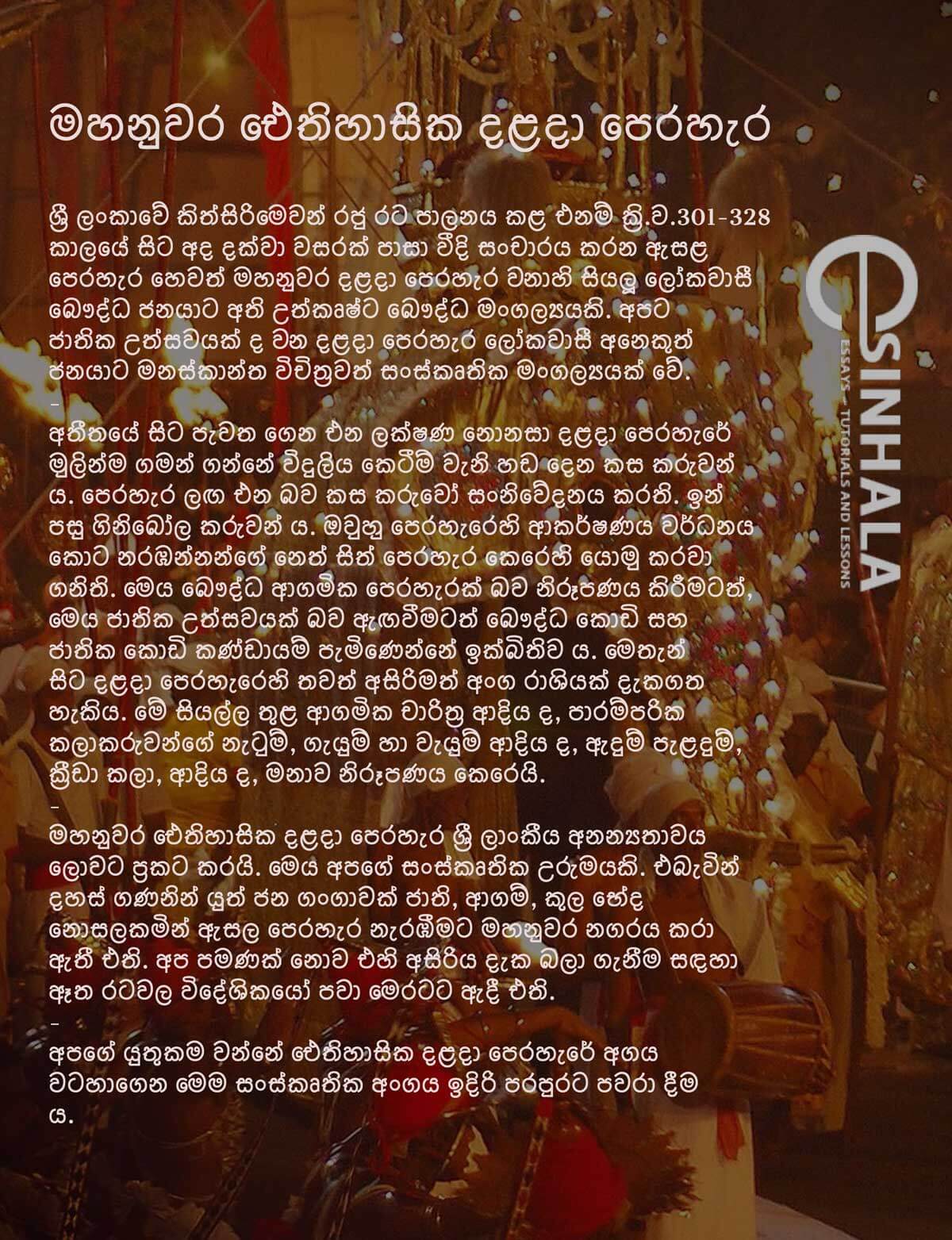
This Essay has 218 words
Total number of words to be = 200 Total Marks = 14
Sinhala essay :- The Kandy Esala Perahera/ Kandy Dalada Pereahera – Grade 8
Shirantha Perera
Related posts.
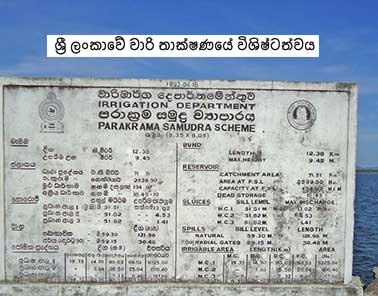
Excellence in Irrigation Technology in Sri Lanka

Christmas Festival

Vesak Festival
28 comments.
THIS IS GREAT ESSAY FOR SRI LANAK I OBEDIENT FOR THIS ESSAY THANK YOU FOR ALL BECAUSE THEY HAVE DO GOO WORK THANK YOU FOR FOR THE LETTER
This was useful to me. Thanks a lot
this essay is very good
Yes it’s very good
this is very helpful with me
????????????
thank u lot
Awesome????????
thank you lot
Daladamperahera in for nation sinhala
this helped me a lot
Leave a Reply Cancel reply
Your email address will not be published. Required fields are marked *

Esala Perahera
Esala Perahera, or the "Esala Procession," is a remarkable and ancient Buddhist festival that takes place every year in the historic city of Kandy, Sri Lanka. With a history that dates back over a millennium, this event is both an extraordinary showcase of Sri Lankan culture and a profoundly spiritual experience for visitors and locals alike.
Held in honor of the Sacred Tooth Relic of the Buddha, the festival is an amalgamation of vibrant music, dance, colorful pageantry, and sacred rituals that make it one of the most spectacular events in Sri Lanka.
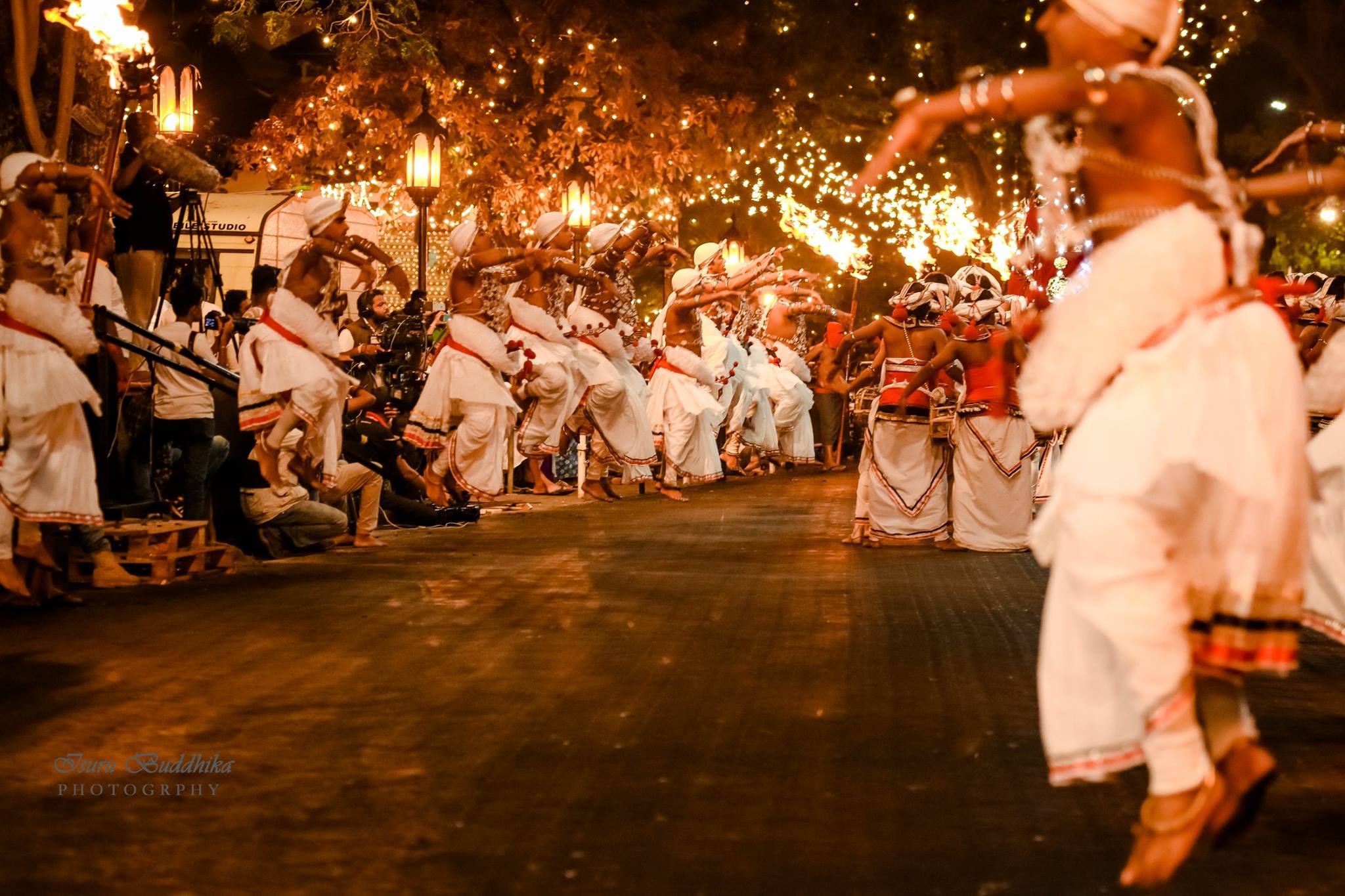
History of the Kandy Esala Perahera
The roots of Esala Perahera can be traced back to the 4th century AD when Princess Hemamali and her husband, Prince Dantha, brought the Sacred Tooth Relic to Sri Lanka from India. It was believed by the people that the ruler who held the relic had the divine right to govern the land.
Throughout the centuries, the Sacred Tooth Relic was housed in several temples across the island. Finally, in the 16th century, it found its permanent home in Kandy's Sri Dalada Maligawa, or the Temple of the Sacred Tooth Relic.
The Esala Perahera festival is organized to honor and pay homage to the Sacred Tooth Relic. It serves as an important spiritual event for the country's Buddhist community.
The Ten-Day Extravaganza
The Esala Perahera is a ten-day event that typically takes place during the months of July or August, with the specific dates being determined by the lunar calendar. The festival is divided into two main parts: the Kumbal Perahera and the Randoli Perahera. The first five days consist of the Kumbal Perahera, which is relatively simple. The second half, the Randoli Perahera, is more elaborate and ends with the grand finale on the tenth day.
The Grand Procession
The highlight of Esala Perahera is undoubtedly the grand procession that occurs on the final night of the festival. A spectacular display of Sri Lankan culture and tradition, the procession is led by a group of skilled drummers who play traditional instruments such as the 'davul,' 'thammattama,' and the 'horanewa'. These drummers set the pace and rhythm for the rest of the procession.
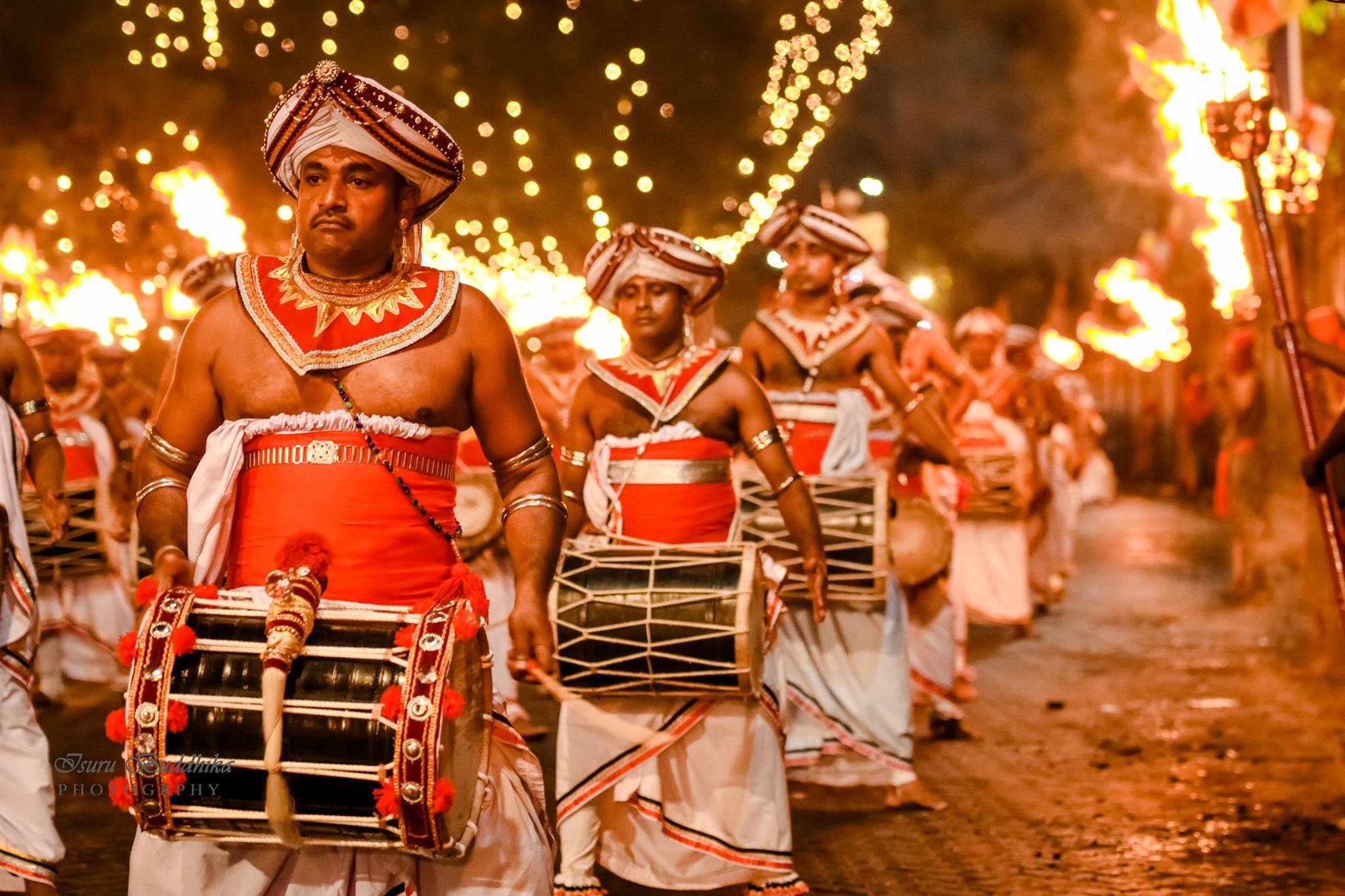
Following the drummers, there are numerous troupes of dancers, including Kandyan dancers, fire dancers, and whip-crackers, all dressed in vivid and intricate traditional attire. The dancers are accompanied by musicians playing flutes, tambourines, and other traditional instruments, creating a lively atmosphere that captivates the audience.
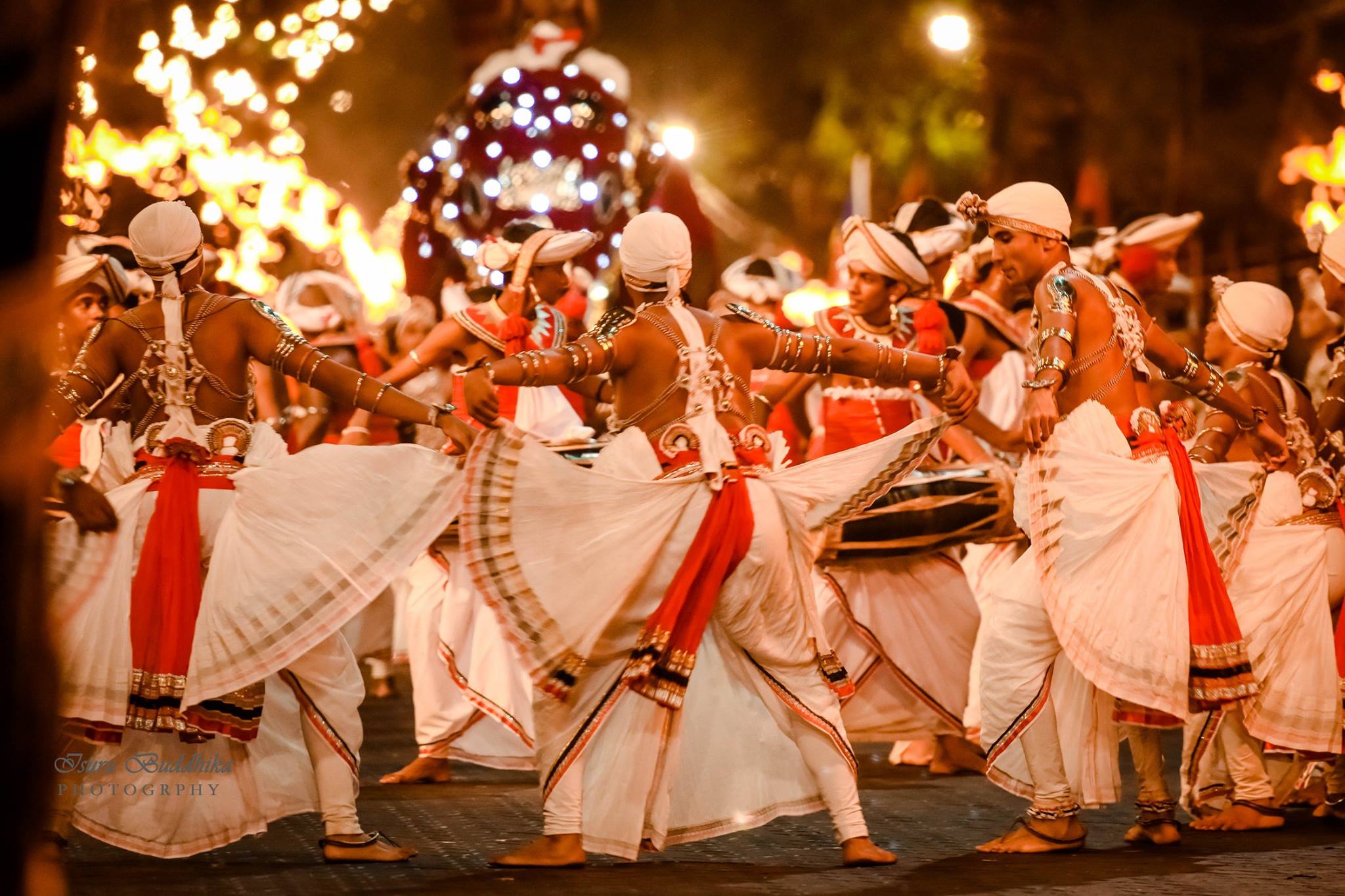
Adding to the visual splendor of the procession are the elaborately decorated elephants adorned with vibrant garments, jewelry, and intricate designs. The most important elephant of the procession carries a replica of the Sacred Tooth Relic in a golden casket on its back. As the procession winds through the streets of Kandy, thousands of locals and tourists gather to witness this unforgettable spectacle.
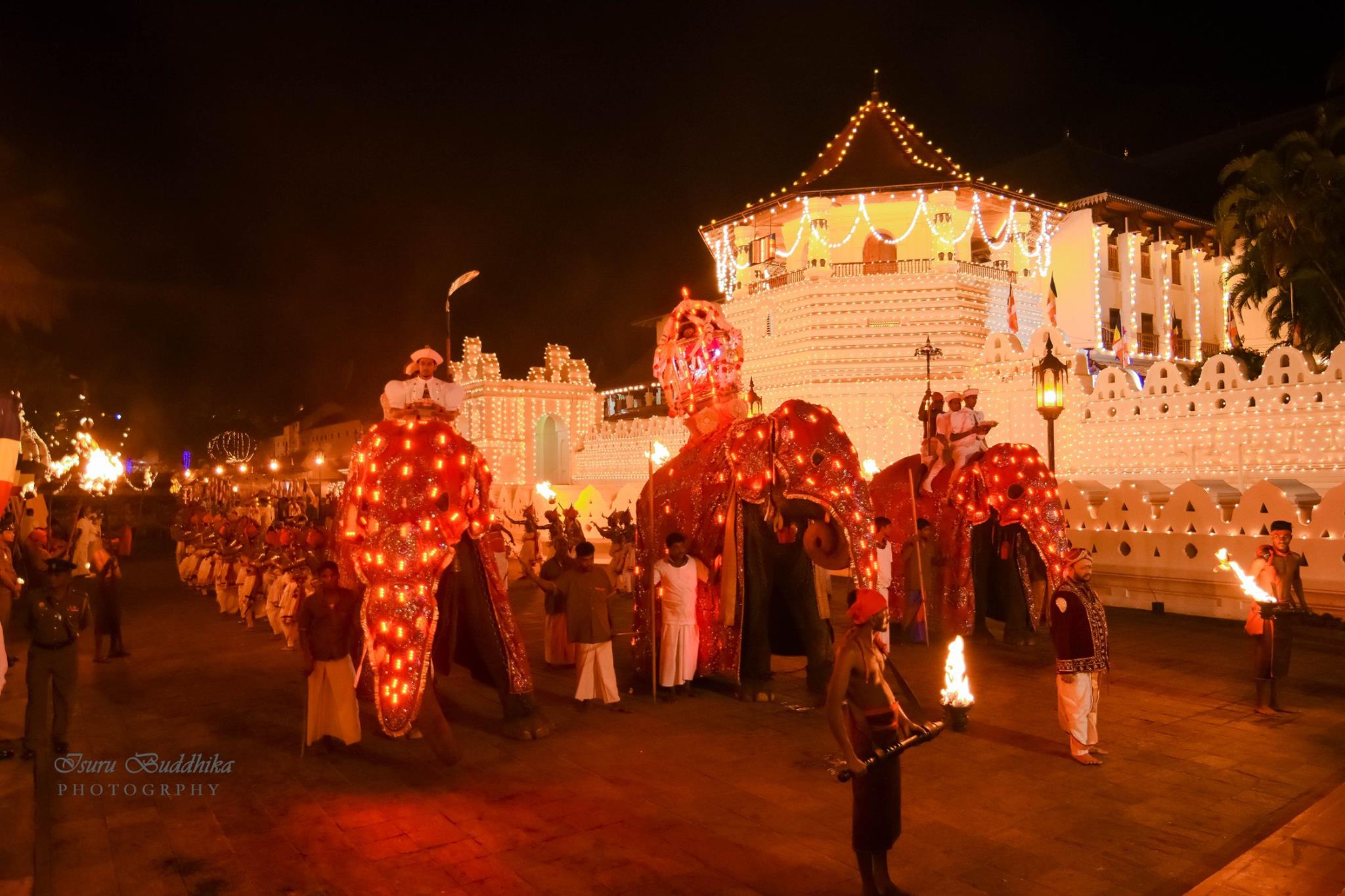
Spiritual Significance of the Esala Perahera in Kandy
Beyond the dazzling display of music, dance, and color, the Esala Perahera holds immense spiritual importance for Sri Lanka's Buddhist community. The festival is a time of grand celebration and deep devotion, with many people participating in religious ceremonies and offering prayers at the Temple of the Sacred Tooth Relic.
It is believed that witnessing the procession brings good luck and blessings, making the event a deeply moving and transformative experience for all who attend.
Experiencing the Esala Perahera as a Tourist
For visitors to Sri Lanka, the Esala Perahera offers a unique opportunity to immerse themselves in the island nation's rich cultural heritage and spirituality. Kandy, a UNESCO World Heritage Site, is a popular tourist destination in its own right, with attractions such as the Royal Palace, the Kandy Lake, and the Peradeniya Botanical Gardens.
The addition of the Esala Perahera brings an extra layer of excitement and spectacle to the city, making it an unforgettable experience for travelers. However, visitors should be prepared for large crowds and limited accommodations during the festival. Due to the influx of tourists and pilgrims, booking accommodations and transportation well in advance is recommended.
Tips for Enjoying the Esala Perahera
- Secure a good viewing spot: To get the best view of the procession, arrive early and find a spot along the main streets of Kandy. Some establishments also offer balcony seating for a fee, providing an unobstructed view of the festivities.
- Dress appropriately: As a religious event, it is important to dress modestly when attending the Esala Perahera. Visitors should avoid revealing clothing and cover their shoulders and knees.
- Wear comfortable footwear: It's important to wear comfortable shoes, as you may be standing for several hours.
- Capture the memories: Bring a camera to capture the stunning visuals of the Esala Perahera. However, be mindful of the local customs and avoid using flash photography near the elephants or during the more solemn moments of the procession.
The Esala Perahera is one of many things you can experience in the beautiful city of Kandy. Find out more in our article about the top things to do in Kandy.
The Esala Perahera is undoubtedly Sri Lanka's most significant religious festival, attracting thousands of visitors annually. With its breathtaking display of colorful elephants, traditional music, dance, and sacred rituals, it is a perfect opportunity for tourists to experience the rich history, culture, and spirituality of Sri Lanka. It will be an unforgettable, once-in-a-lifetime experience that you will cherish for years to come.
Wonders Of Ceylon

The Majestic Esala Perahera Festival: A Celebration of Sri Lanka’s Rich Cultural Heritage
Are you searching for an adventure that immerses you in rich cultural heritage? Consider the Esala Perahera Festival , one of Sri Lanka’s most vibrant celebrations dating back centuries .
This blog post will guide you through this majestic event, from its historic origins to its grand procession and festivities . Ready for a journey into Sri Lankan culture like no other? Let’s dive in!
Table of Contents
Key Takeaways
- The Esala Perahera Festival is a vibrant celebration in Sri Lanka that showcases the country’s rich cultural heritage.
- It has a long history dating back centuries and has evolved over time, blending ancient traditions with modern influences.
- The festival is deeply rooted in Buddhism and includes religious rituals and ceremonies to honor the Sacred Tooth Relic of Buddha.
- The grand procession of the festival features ornately decorated elephants, traditional dancers, musicians, and firebreathers.
- Despite changes due to colonial rule and modernization, efforts have been made to preserve the festival’s traditional aspects while ensuring accessibility for all.
- The Esala Perahera Festival attracts tourists from around the world and has gained global recognition for its cultural significance.
Historical Background of the Kandy Esala Perahera
Legends and myths surround the origins of the Kandy Esala Perahera, which has evolved over time due to colonial influence and modernization into a spectacular event that attracts global recognition today.
https://www.youtube.com/watch?v=v_TjXkAdHwU
Legends and Myths
Old tales tell us about this festival. One tale talks about the gods in the sky . Long ago, they needed rain for their crops to grow . They made loud music and held a parade to ask help from God Indra , the god of rains.
The Esala Perahera happened because of this legend . Now it has more meaning. Today, people honor Buddha’s Tooth Relic during the parade too! This relic is very special to Sri Lankan Buddhists and it gets carried through Kandy city every year at this time.
Evolution of the Festival
The Esala Perahera festival in Kandy, Sri Lanka has a long and fascinating history . It has evolved over the centuries, blending ancient traditions with modern influences . The festival started many years ago as a simple religious procession to honor the Sacred Tooth Relic of Buddha .
However, with time, it has grown into a grand affair that showcases Sri Lanka’s rich cultural heritage . The influence of colonial rule brought changes to the festival, making it more elaborate and spectacular.
Today, the Esala Perahera attracts tourists from around the world and is recognized globally for its cultural significance . Despite these changes, efforts have been made to preserve the traditional aspects of the festival while ensuring accessibility for all.
Influence of Colonial Rule
During the colonial rule, the Esala Perahera festival in Sri Lanka faced some changes and challenges. The Portuguese, Dutch, and British administrations had different impacts on the festival.
They imposed restrictions and regulations that affected the traditional practices of the procession. For example, during British colonial rule , they banned the use of firecrackers due to safety concerns.
Additionally, there was an effort to secularize the festival by removing its religious elements. However, despite these influences, the Esala Perahera managed to adapt and evolve while maintaining its cultural significance .
Another effect of colonial rule was increased exposure to Western culture through trade and colonization. This led to a fusion of local traditions with foreign influences in aspects such as costumes and music.
As a result, you can see hints of European styles in some performances during the procession.
Modernization and Spectacle
The Esala Perahera festival has also evolved with modernization , becoming a spectacular event that combines tradition with innovation . Over the years, the festival has embraced new technologies and techniques to enhance the grandeur of the procession.
Today, you can expect to see colorful LED lights illuminating the night sky as elephants adorned in magnificent regalia make their way through the streets. The addition of fire breathers and acrobats adds an element of excitement and awe to the performances.
Despite these modern touches, the festival maintains its cultural significance and spiritual essence, keeping alive Sri Lanka’s rich traditions for future generations to cherish.
Increased Tourism and Global Recognition
The Esala Perahera festival in Kandy, Sri Lanka has gained increased tourism and global recognition over the years. Thousands of local and international visitors flock to witness this grand cultural spectacle .
This not only boosts the economy but also puts Sri Lanka on the map as a must-visit destination for adventure travelers seeking to immerse themselves in rich cultural experiences. The festival’s unique blend of sacred rituals, traditional dances, vibrant music performances, and awe-inspiring parade with majestic elephants has garnered attention worldwide.
It serves as a testament to the beauty and vibrancy of Sri Lankan heritage, attracting people from all walks of life who want to be part of this extraordinary celebration.
Preservation of Tradition and Accessibility
The Esala Perahera festival in Kandy, Sri Lanka is not only about celebrating the rich cultural heritage of the country but also about preserving and promoting traditional arts and customs .
The festival’s organizers place great importance on maintaining the authenticity of the event by ensuring that ancient rituals are faithfully followed and traditional costumes are worn during performances.
At the same time, they strive to make the festival accessible to all by organizing events that cater to different interests and preferences. This includes offering various viewing options for visitors , such as grandstands or standing areas, so that everyone can enjoy the parade comfortably.
Rituals and Preparations for the Esala Perahera
Elaborate preparations are made for the Esala Perahera, including religious rituals and ceremonies that add to the sacredness of the festival.
Elaborate Preparations
The Esala Perahera festival in Kandy, Sri Lanka involves elaborate preparations to ensure a memorable and awe-inspiring experience for all attendees. Here are some key aspects of the preparations:
- Intricate Planning : The organizers meticulously plan every detail of the festival, from the route of the procession to the performances and ceremonies involved.
- Decorations and Lighting : The streets of Kandy are adorned with beautiful decorations, colorful lights, and traditional ornaments to create a festive ambiance.
- Construction of Stages : Various stages are constructed along the parade route for cultural performances and religious rituals to take place.
- Rehearsals and Training : Dancers, drummers, musicians, and other performers undergo rigorous rehearsals and training sessions to perfect their art and ensure seamless performances during the festival.
- Elephant Care : Special attention is given to the well-being of the elephants participating in the procession. They are bathed, fed, and cared for by skilled mahouts (elephant handlers) to ensure their welfare throughout the festival.
- Security Measures : Strict security measures are put in place to maintain order and ensure the safety of both participants and spectators.
Religious Rituals and Ceremonies
The Esala Perahera festival in Kandy, Sri Lanka, is a celebration deeply rooted in Buddhism and rich with religious rituals and ceremonies. During the 10-day festival, devotees come together to pay homage to the Sacred Tooth Relic of Buddha, which is enshrined at the Sri Dalada Maligawa temple in Kandy. Here are some of the religious rituals and ceremonies that take place during the Esala Perahera:
- Offering of flowers and incense : As a sign of respect and devotion, participants offer fresh flowers and light incense sticks at the temple.
- Chanting of prayers : Monks chant Buddhist scriptures and prayers throughout the festival to invoke blessings and cultivate peace and serenity.
- Lighting oil lamps : Oil lamps are lit to symbolize enlightenment and dispel darkness. This ritual is believed to bring good fortune and protect against negative influences.
- Almsgiving : Devotees offer food, clothing, or other necessities to monks as an act of generosity and merit-making.
- Procession of the Sacred Tooth Relic : The most sacred moment of the festival is when a replica of the Sacred Tooth Relic is paraded through the streets on a majestic elephant. This represents the presence of Buddha’s teachings among the people.
- Blessings by monks : Throughout the procession, monks bless attendees by sprinkling holy water and reciting blessings.
- Offerings made by performers : Dancers, drummers, musicians, firebreathers, and other performers also make offerings at each major stop during the parade as a way to seek blessings for their talents.
- Participation in religious ceremonies : Visitors have opportunities to participate in traditional Buddhist ceremonies such as meditation sessions or listening to dharma talks by esteemed monks.
- Reflection and self-purification : Many participants use this time for personal reflection, seeking forgiveness for past actions, purifying their minds, and committing to practicing kindness and compassion.
- Receiving blessings from relics : Some participants have the opportunity to receive blessings from relics believed to be connected to Buddha or other revered figures in Buddhism.
Parade and Procession of the Perahera
The Parade and Procession of the Perahera captivates spectators with its grandeur, as traditional dancers, musicians, and firebreathers mesmerize the crowd while adorned elephants lead the way.
Grandeur and Scale of the Parade
The Esala Perahera festival in Kandy, Sri Lanka, is known for its grandeur and scale . The procession features majestic elephants adorned in ornate regalia , accompanied by dancers, drummers, and traditional musicians .
It’s a mesmerizing display of vibrant colors and electrifying performances that create an unforgettable atmosphere. The parade follows a strict order, with different groups representing various aspects of Sri Lankan culture and history.
Thousands of local and international visitors gather to witness this awe-inspiring event, immersing themselves in the richness of Sri Lanka’s cultural heritage.
Traditional Costumes and Attire
The traditional costumes and attire worn during the Esala Perahera festival are absolutely breathtaking. The performers dress in vibrant and ornate outfits that reflect the rich cultural heritage of Sri Lanka.
Dancers wear colorful sarongs, intricately embroidered jackets, and headdresses adorned with feathers and jewels . Musicians showcase their talent while wearing traditional white robes known as “amude.” The elephants, which play a central role in the procession, are beautifully decorated with bright fabrics, elaborate jewelry, and large ceremonial umbrellas.
It is truly a sight to behold as these majestic creatures parade through the streets accompanied by dancers, drummers, and firebreathers.
Mesmerizing Performances and Cultural Displays
The Esala Perahera festival in Kandy, Sri Lanka, is known for its mesmerizing performances and vibrant cultural displays . During the grand procession, you’ll be captivated by the sight of majestic elephants adorned with elaborate regalia .
Accompanying them are talented dancers who perform traditional dances to the beat of drummers and musicians playing traditional instruments . The atmosphere is electrifying as firebreathers showcase their skills, adding an element of excitement to the celebration.
This festival offers a unique opportunity to experience the rich cultural heritage of Sri Lanka through dazzling performances that will leave you in awe.
Cultural Significance of the Esala Perahera
The Esala Perahera holds great cultural significance, promoting unity and harmony among the Sri Lankan people. It showcases the rich traditions of the country and serves as a reminder of its deep-rooted Buddhist heritage.
Discover more about this mesmerizing festival and its profound impact on Sri Lankan culture.
Religious and Cultural Importance
The Esala Perahera festival holds great religious and cultural significance in Sri Lanka. It is a time when the country comes together to honor its rich heritage and traditions. With Buddhist origins, the festival pays homage to the Sacred Tooth Relic of Buddha, which is revered as a symbol of spiritual power and protection.
The procession showcases different aspects of Sri Lankan culture , from traditional dance performances to vibrant music displays . Through this festival, locals express their deep-rooted beliefs and values while promoting unity and harmony among diverse communities.
The Esala Perahera serves as a reminder of the country’s cultural identity and plays a crucial role in preserving and safeguarding these traditions for future generations to cherish.
Promotion of Unity and Harmony
The Esala Perahera festival in Sri Lanka not only celebrates the country’s cultural heritage but also promotes unity and harmony among its diverse population . People from different ethnicities and backgrounds come together to witness this grand event, showing that despite their differences, they can unite in appreciation of their shared traditions .
The procession itself represents various aspects of Sri Lankan culture and history, showcasing the rich tapestry of the country’s identity. This celebration serves as a reminder that no matter our individual beliefs or backgrounds, we can all come together to celebrate and embrace our shared humanity.
Visitor Experience and Impact
Visitors to the Esala Perahera are treated to a mesmerizing display of traditional dance, music, and cultural performances that truly showcase Sri Lanka’s rich heritage. Read on to discover the economic and tourism impact this festival has on the country and how initiatives are being taken to safeguard and promote it for future generations.
Tips for Attending as a Visitor
Here are some tips for adventure travelers attending the Esala Perahera festival in Kandy, Sri Lanka:
- Plan your visit during the festival : The Esala Perahera is usually held in July or August , so make sure to check the exact dates and plan your trip accordingly.
- Arrive early to secure a good viewing spot : The parade attracts large crowds, so it’s best to arrive early to find a good spot along the procession route. You don’t want to miss any of the action!
- Dress appropriately : The festival is a religious event, so it’s important to dress modestly and respectfully . Wear comfortable clothes and shoes as you may be standing for long periods of time.
- Bring sunscreen and a hat : The festival takes place outdoors, and Sri Lanka can get quite hot during this time of year. Protect yourself from the sun by applying sunscreen and wearing a hat.
- Stay hydrated : It’s essential to stay hydrated throughout the day, especially if you’re going to be out in the sun for an extended period of time. Carry a water bottle with you and drink plenty of fluids.
- Observe local customs and etiquette : Show respect for the cultural traditions by following local customs. Be mindful of where you stand or sit, avoid touching sacred objects without permission, and refrain from taking photographs during religious rituals.
- Immerse yourself in the experience : Take in the sights, sounds, and smells of the festival by fully immersing yourself in the experience. Listen to traditional music, watch mesmerizing dance performances, and enjoy the vibrant atmosphere.
- Try local cuisine : Take advantage of being in Sri Lanka by trying traditional dishes at local food stalls or restaurants near the festival grounds. Don’t miss out on experiencing the flavors of Sri Lankan cuisine!
Economic and Tourism Impact
The Esala Perahera festival has a significant impact on the economy and tourism in Sri Lanka. With thousands of visitors from around the world attending this grand event, it brings in revenue for local businesses such as hotels, restaurants, and souvenir shops.
The festival also creates job opportunities for various industries, including transportation, hospitality, and entertainment sectors. Additionally, the increased tourism during the festival helps to promote Sri Lanka as a cultural destination globally.
This not only boosts the country’s economy but also encourages the preservation of its rich cultural heritage for future generations to experience and enjoy.
Initiatives for Safeguarding and Future Promotion
To ensure the preservation and future promotion of the Esala Perahera festival, several initiatives have been implemented. The Sri Lankan government has taken steps to safeguard this cultural heritage by providing financial support for its organization and maintenance.
In addition, there are ongoing efforts to train and mentor young artists in traditional forms of music, dance, and craftsmanship, ensuring that these skills are passed down to future generations.
Furthermore, educational programs have been established to raise awareness about the significance of the festival among local communities and visitors alike. These initiatives not only protect the integrity of the event but also contribute to its continued popularity as a vibrant celebration of Sri Lanka’s rich cultural heritage.
The Esala Perahera festival is a vibrant and captivating celebration of Sri Lanka’s cultural heritage. With its grand procession, traditional performances , and religious significance , it offers visitors a unique and immersive experience.
This festival not only showcases the rich traditions and customs of the country but also plays an important role in preserving them for future generations to appreciate.
1. When does the Esala Perahera Festival take place?
The Esala Perahera Festival takes place in the month of July or August, according to the full moon in Sri Lanka’s cultural city of Kandy.
2. What is the significance of the Esala Perahera Festival?
The Esala Perahera Festival is a celebration of Sri Lanka’s rich cultural heritage and is held to honor the Sacred Tooth Relic of Lord Buddha, believed to be housed in Kandy.
3. What can I expect at the Esala Perahera Festival?
At the festival, you can witness a grand procession featuring beautifully adorned elephants, traditional dancers, drummers, fire performers, and various religious rituals.
4. Can anyone participate or attend the Esala Perahera Festival?
Yes, anyone can attend and enjoy the festivities of the Esala Perahera Festival as it is open to locals and tourists alike. However, participating in certain religious rituals may require permission or involvement from designated authorities.

Melanie Cho is a passionate traveler, storyteller, and cultural enthusiast with a heart that bridges the landscapes of Korea and Sri Lanka. As a 28-year-old Korean woman who spent her formative years splitting time between these two captivating worlds, Melanie’s unique upbringing ignited her love for exploration and connection. Her intimate knowledge of both cultures enables her to share authentic insights, captivating stories, and practical tips that inspire fellow adventurers to embark on unforgettable journeys.
Similar Posts

Ultimate Guide to Glamping in Sri Lanka: Discover the Best Luxury Camping Spots
Ready for a luxurious getaway in the wild? Sri Lanka’s burgeoning glamping scene offers travelers the perfect blend of adventure and comfort. This comprehensive guide lets you in on the best luxury camping spots dotting this tropical paradise, providing everything from booking tips to must-see nearby attractions. Let’s dive right into your next glorious vacation!…

Exploring the Best Dive Sites in Sri Lanka
Intrigued by the prospect of a surreal underwater adventure? Sri Lanka, surrounded by azure waters housing over 26 breath-taking dive sites, could be your next scuba diving destination. This article takes you on a journey through the best dive spots this tropical paradise has to offer, along with valuable insights on diving schools and optimal…

Exploring the Ancient Stupas in Sri Lanka: A Buddhist Architectural Marvel
Curious about ancient architecture and its historical significance? Sri Lanka’s stupas, considered Buddhist architectural marvels, are sure to captivate your interest. This article delves into the enchanting world of these structure, providing insights on their design, importance in Buddhism, and how you can explore them. Unearth the wonders of sacred relics and centuries-old stories waiting…

Discover the Diversity of Butterflies in Sri Lanka
Are you an adventurer seeking to explore the vibrant world of butterflies in Sri Lanka? With a rich diversity of 248 known butterfly species, this tropical island is a must-visit for all nature enthusiasts. Our article will take you on a fascinating journey through Sri Lanka’s unique butterfly habitat, highlighting endemic species and conservation efforts….

Exploring Sri Lankan Wedding Traditions and Rituals
Weddings are a joyous occasion, but understanding the intricacies of another culture’s traditions can be challenging. For instance, Sri Lankan wedding ceremonies are known to be vibrantly colorful and richly steeped in ancient customs. This blog will shed light on these unique rituals and traditions, helping you appreciate the depth and beauty of a Sri…

The Ultimate Guide to Wellness Retreats in Sri Lanka
Feeling overwhelmed and in need of a restorative getaway? Sri Lanka, an island surrounded by the Indian Ocean, is renowned for its luxurious wellness retreats. Our ultimate guide offers insights into the top-notch sanctuaries that promote holistic health and relaxation. Dive into this article to uncover your next dream destination to rejuvenate body, mind, and…
Leave a Reply Cancel reply
Your email address will not be published. Required fields are marked *
Save my name, email, and website in this browser for the next time I comment.

Places to Visit Culture
Kandy esala perahera: a guide to experiencing sri lanka’s famous festival.
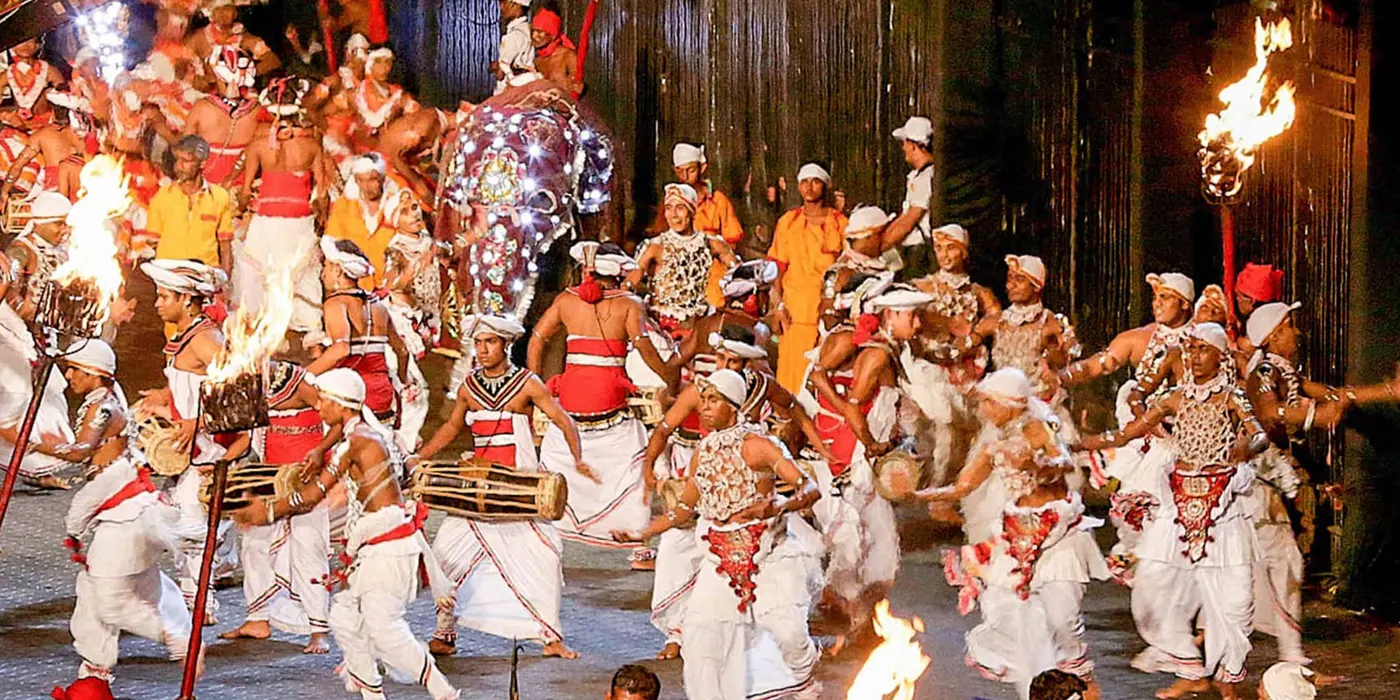
Kandy Esala Perahera is an annual grand festival celebrated in the city of Kandy, Sri Lanka. It is one of the most magnificent and oldest Buddhist festivals in Sri Lanka, attracting both locals and tourists from around the world.
This unique cultural event showcases the rich heritage, religious devotion, and traditional customs of the Sri Lankan people. The Kandy Esala Perahera promises to be a captivating spectacle filled with color, music, dance, and religious fervor.
The Chief Custodian of the Temple of the Sacred Tooth Relic in Kandy has officially announced the dates for the Esala Procession 2023.
The ‘Kumbal’ procession is set to occur from August 21st to August 25th, and it will be followed by the ‘Randoli’ procession from August 26th to August 30th.
Quick Links To Explore
Introduction to Kandy Esala Perahera
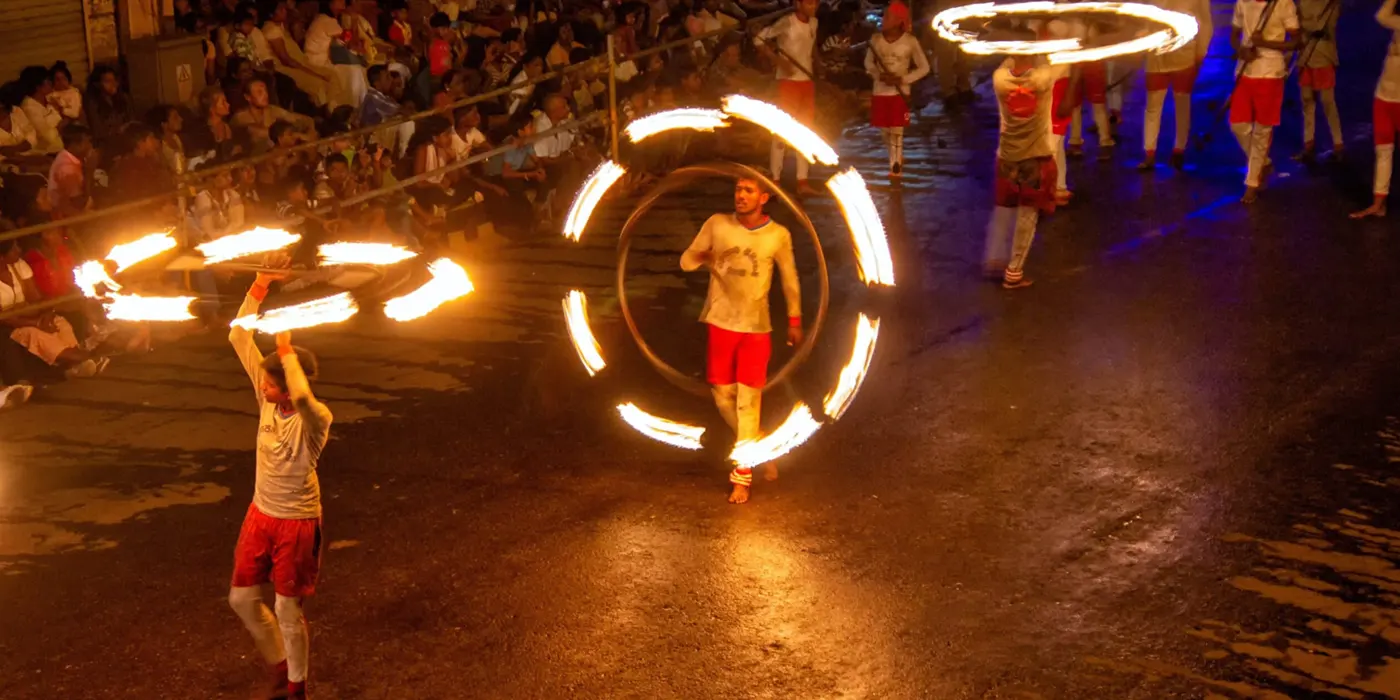
The Kandy Esala Perahera is a vibrant religious procession that takes place during the month of Esala (July/August) in Kandy, Sri Lanka.
It is dedicated to the Sacred Tooth Relic of Lord Buddha, which is housed in the Temple of the Tooth (Sri Dalada Maligawa) in Kandy. The festival spans over ten days and culminates in the grand finale, known as the Randoli Perahera.
Historical Significance of Kandy Esala Perahera
The origins of the Kandy Esala Perahera can be traced back to the 3rd century BC when the Tooth Relic was brought to Sri Lanka . Over the centuries, the Perahera has evolved and grown in scale, becoming an integral part of Sri Lankan culture. It is believed to bring blessings, prosperity, and protection to the country and its people.
Preparation and Preparatory Events
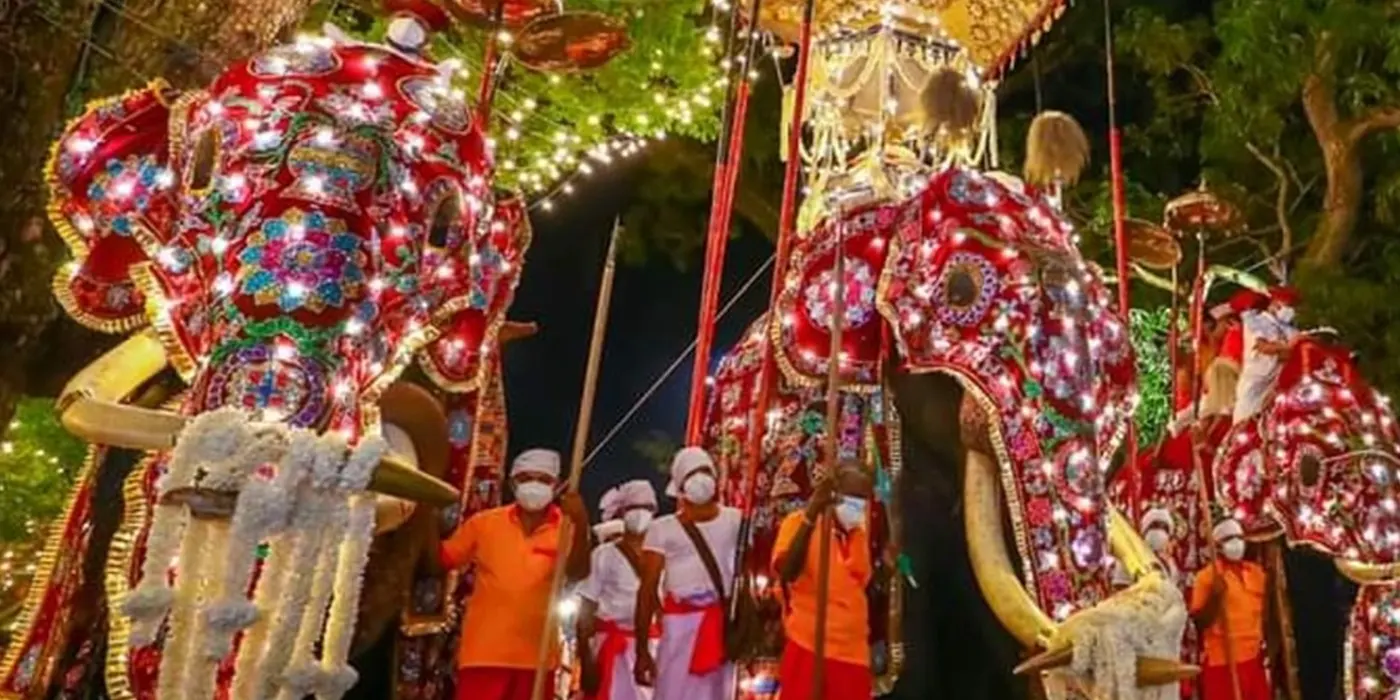
Months before the Perahera, preparations begin with the selection of tuskers, who will carry the caskets containing the Sacred Tooth Relic. These majestic elephants are adorned with elaborate costumes and ornaments. The streets of Kandy are decorated with vibrant lights, and the temple complex is meticulously prepared for the festivities.
Rituals and Ceremonies
The Perahera consists of a series of rituals and ceremonies. It starts with the Kap Situveema ceremony, where the cutting of a sanctified jackfruit tree symbolizes the beginning of the festival. Daily rituals, including the morning and evening ‘Dalada Maligawa’ rituals, are performed throughout the ten-day period.
Elephants in the Perahera
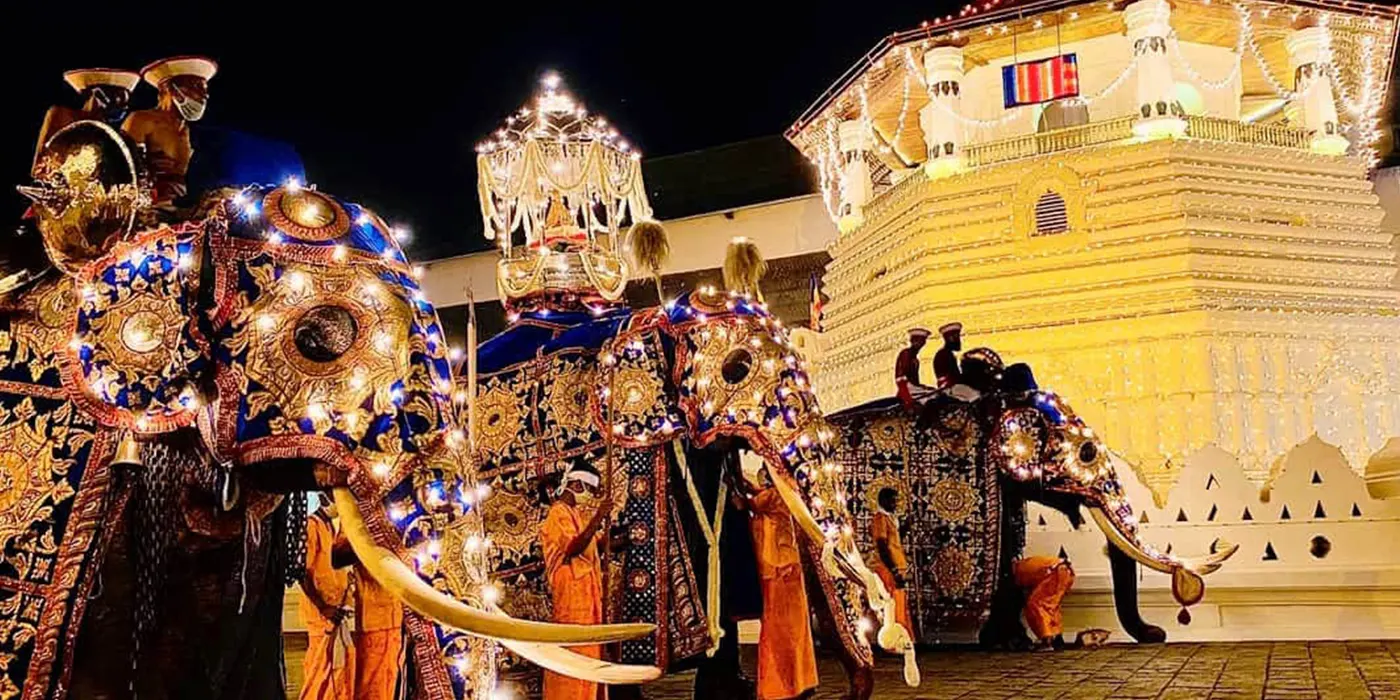
The elephants play a significant role in the Kandy Esala Perahera. They are beautifully decorated and carry the sacred relics in golden caskets on their backs. The majestic sight of these adorned elephants, accompanied by traditional drummers and flag bearers, is a highlight of the festival.
Traditional Dances and Music
The Perahera showcases a wide variety of traditional dances and music. Dancers, drummers, and other performers clad in vibrant costumes entertain the spectators along the procession route. The rhythmic beats of drums, the melodious tunes of flutes, and the graceful movements of the dancers create a mesmerizing ambiance.
Costumes and Ornaments
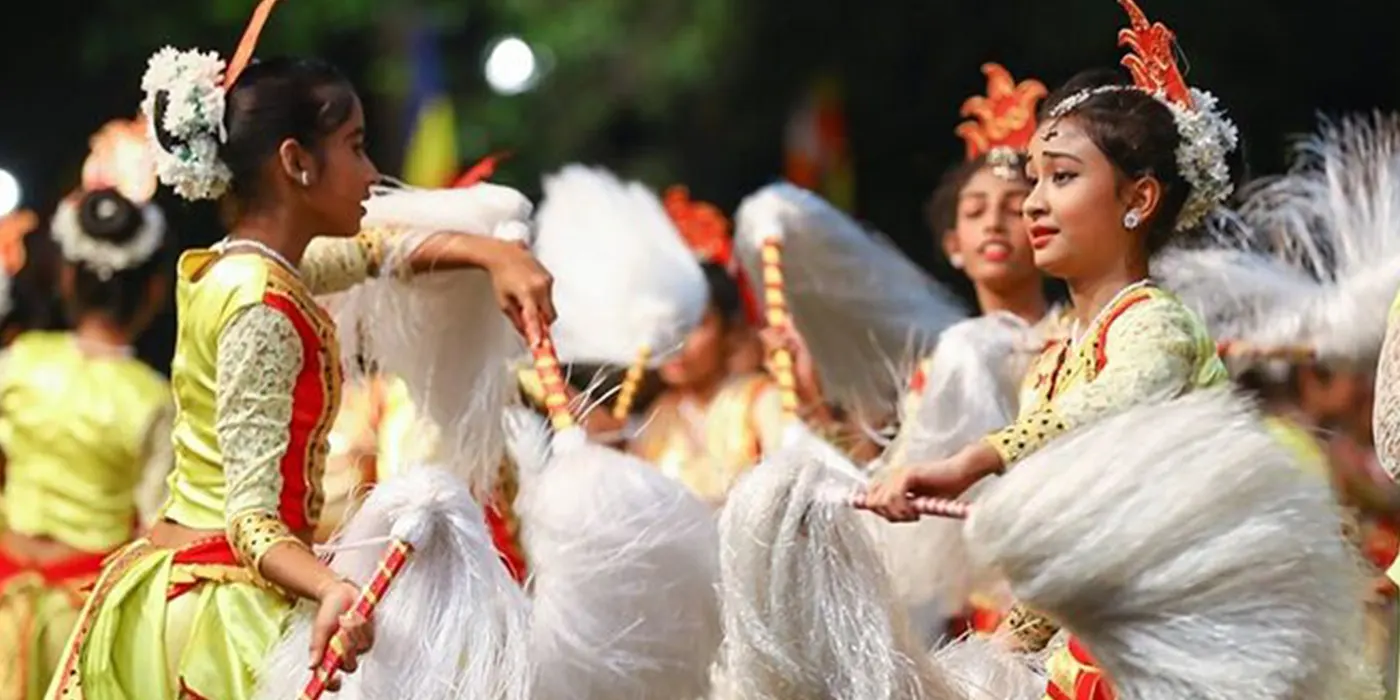
The participants in the Perahera wear colorful costumes and intricate ornaments. The dancers don traditional attire representing different cultural traditions of Sri Lanka. These ornate costumes, combined with the vibrant colors, add to the visual splendor of the event.
Lighting and Decorations
During the Kandy Esala Perahera, the city of Kandy is illuminated with elaborate light displays. Streets and buildings are adorned with colorful decorations, creating a festive atmosphere. The beautifully lit procession adds to the magical charm of the event, attracting spectators from far and wide.
Procession Route and Timings
The Perahera follows a specific route through the streets of Kandy. The procession starts from the Temple of the Tooth and proceeds along a predetermined path, passing through several important locations in the city.
The timings of the Perahera may vary, but it usually takes place in the evenings, allowing visitors to witness the spectacle under the night sky.
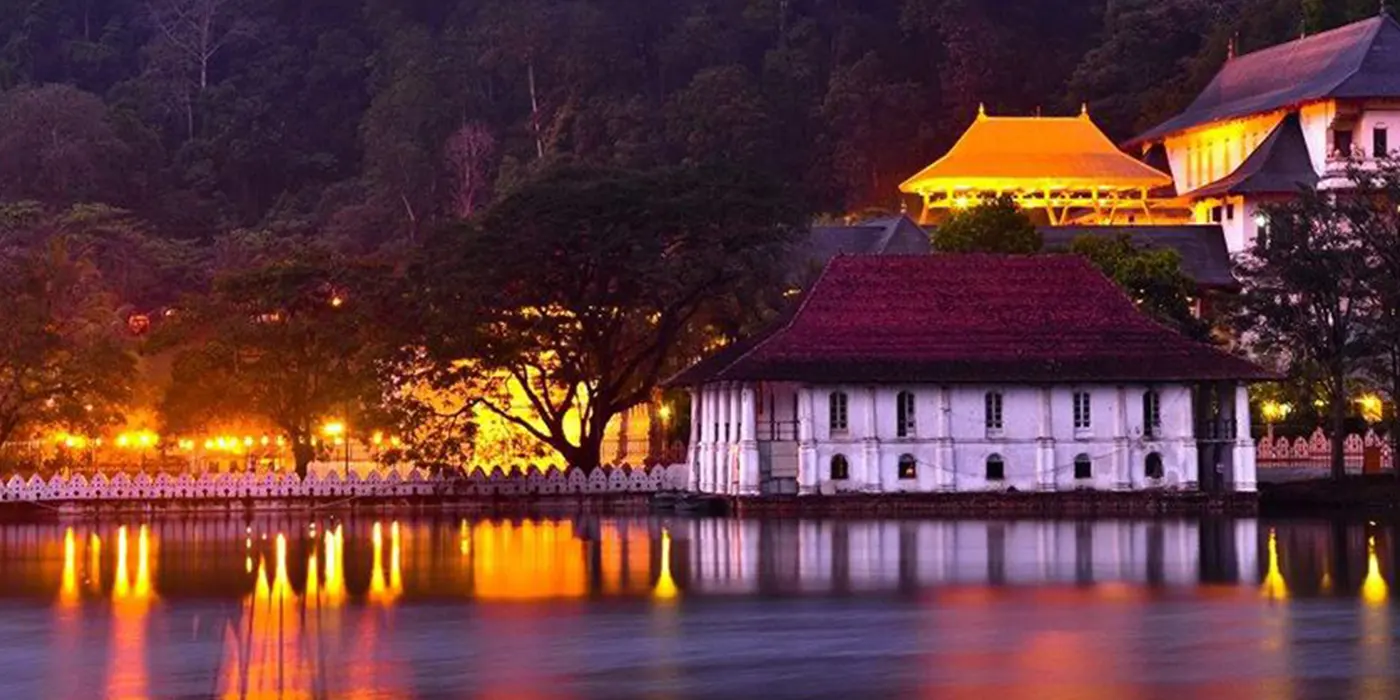
Crowds and Accommodation
The Kandy Esala Perahera attracts a large number of spectators each year, both local and international. It is advisable to plan your visit in advance and book accommodation well ahead of time, as the city gets crowded during the festival. Many hotels and guesthouses offer special packages for visitors attending the Perahera.
Best Viewing Spots
To get the best experience of the Kandy Esala Perahera, it is essential to choose the right viewing spot. The area around the Temple of the Tooth provides an up-close view of the procession. Other popular spots include the Queen’s Hotel, Dalada Veediya (Tooth Relic Street), and the Kandy Lake bund.
Food and Refreshments
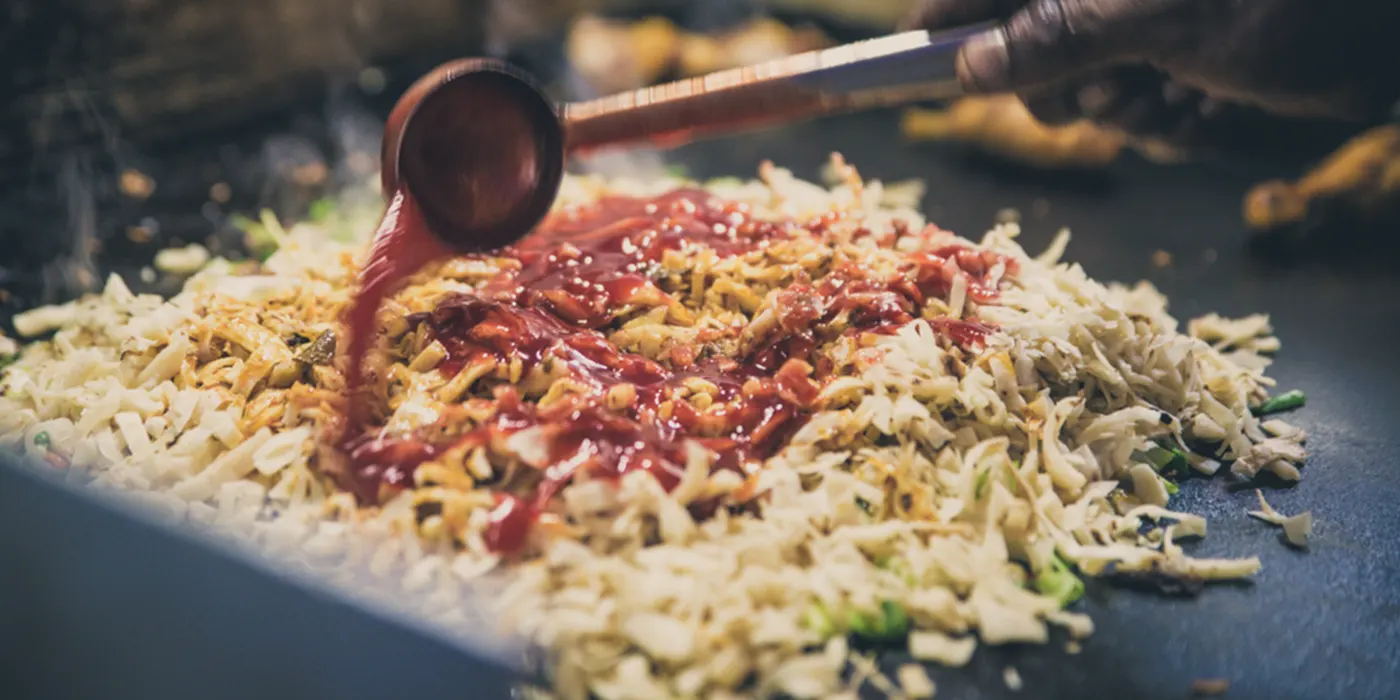
During the festival, numerous food stalls and vendors line the streets, offering a variety of local delicacies and refreshments. Visitors can indulge in traditional Sri Lankan dishes such as hoppers, kottu roti, and string hoppers . It is an excellent opportunity to savor the flavors of the island while enjoying the festivities.
Cultural Impact and Tourism
The Kandy Esala Perahera holds immense cultural significance in Sri Lanka. It is not only a religious festival but also an event that showcases the country’s rich heritage. The festival has a significant impact on tourism, attracting visitors from all over the world who come to witness this cultural extravaganza.
Preserving Tradition
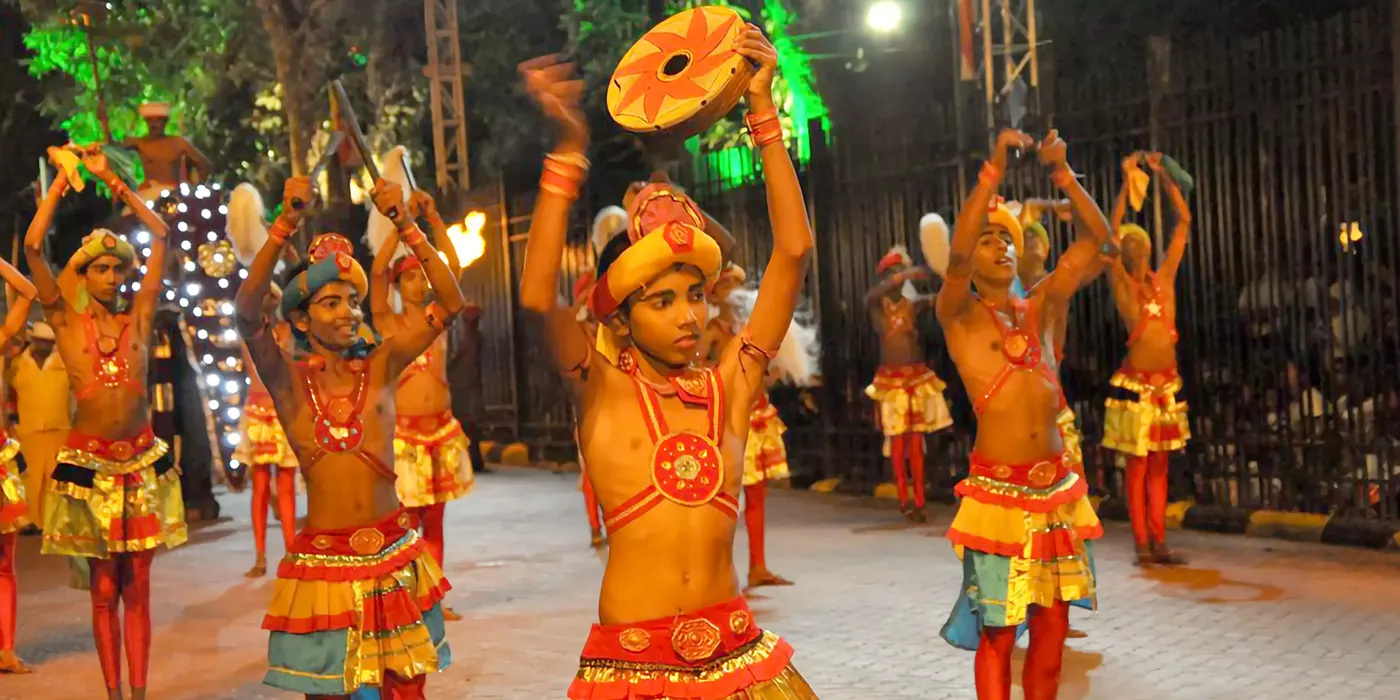
Efforts are made to preserve and promote the traditions associated with the Kandy Esala Perahera. The younger generation is encouraged to participate and learn the traditional dances and rituals, ensuring that these cultural practices continue to thrive for generations to come. Organizations and individuals work together to safeguard this important cultural heritage.
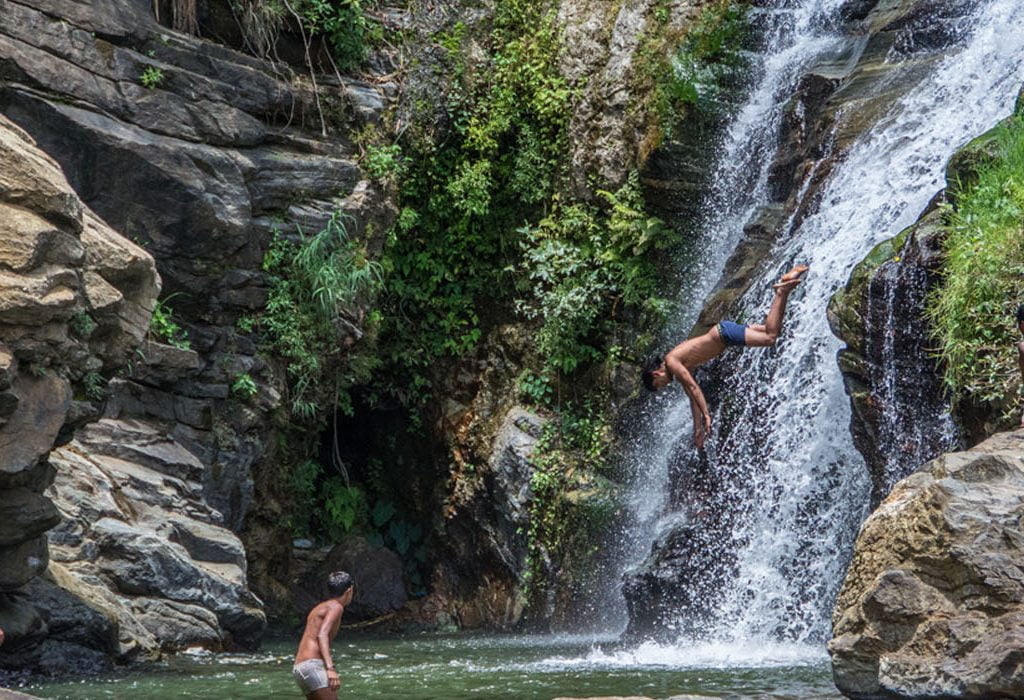
Sri Lanka Tour Packages
Our Sri Lanka tour packages offer the perfect way to explore this beautiful island. We have a variety of packages to choose from, so you can find one that fits your interests and budget. We can also create a custom itinerary for you.
The Kandy Esala Perahera is a mesmerizing festival that showcases the cultural richness of Sri Lanka. With its vibrant processions, traditional dances, and religious rituals, it offers a unique and unforgettable experience for visitors. The festival not only celebrates the country’s heritage but also fosters a sense of unity and devotion among its people.
What is the significance of the Kandy Esala Perahera?
The Kandy Esala Perahera is a religious festival dedicated to the Sacred Tooth Relic of Lord Buddha and holds immense cultural significance in Sri Lanka.
How long does the Kandy Esala Perahera last?
The festival spans over ten days, with the grand finale known as the Randoli Perahera.
Where does the Perahera take place?
The Perahera takes place in the city of Kandy, Sri Lanka, starting from the Temple of the Tooth.

Comments are closed.
Copyright © 2024 Lanka Tour Experts. All Rights Reserved.

The Ultimate Africa Travel Bucket List
- A Brief History
- Sri Lankan Culture
- Climate and Weather
- Best Tourist Destinations
- The Best Time To Visit
- What to Take
- What to Wear
- What to Eat
- What to Drink
- Health Facilities
- Vaccinations for Sri Lanka
- Geography of Sri Lanka
- Religions in Sri Lanka
- Driving in Sri Lanka
- Travel by Car / Rent a Car
- Travel by Bus
- Travel by Train
- Travel by Trishaw (Tuk-Tuk)
- Taxi Hire in Sri Lanka
- Guided Tours in Sri Lanka
- Customs Regulations
- Sri Lankan Visa – Tourist
- Banking & Business Hours
- Sri Lanka Holidays – 2019
- Sri Lankan Currency
- Exchange Rates
- Sri Lanka Currency & Banks
- Antiques & Furniture Export
- Colombo District
- Galle District
- Kandy District
- Nuwara Eliya District
- Ratnapura District
- Anuradhapura District
- Polonnaruwa District
- Sri Lankan Nature
- Arugam Bay Beach
- Bentota Beach
- Beruwala Beach
- Galle Beach
- Hikkaduwa Beach
- Jaffna Beach
- Kalkudah Beach & Passekudah Bay
- Kalpitiya Beach
- Koggala Beach
- Mount Lavinia Beach
- Negombo Beach
- Nilaveli Beach
- Tangalle Beach
- Trincomalee Beach
- Unawatuna Beach
- Weligama Beach
- Sacred Sites and Religious Attractions
- Ancient Cities
- Parks and Gardens
- Camping Holidays
- Rock Climbing
- Wildlife Tours & Safaris
- Boat Safaris
- Water Sports
- Hiking and Trekking
- Cycling Vacations
- Playing Golf
- Ayurveda & Spa Resorts
- What to Buy
- Shopping Tips
- Sri Lanka Duty Free
- Submit an Article
- Advertise With Us
The Esala Perahera in Kandy (Kandy Perahera)
The famous Kandy Perahara (Esala Perahara / the festival of the tooth) is one of the most important annual Buddhist celebrations takes place in Sri Lanka and it is also considered as one of the most spectacular religious processions in Asia. Sri Lankans from all over the country and an ever increasing number of foreign visitors annually gather in Kandy to witness this colourful pageantry.
The highlight of Kandy Perahera is got to be the colourful and multi-faceted processions that feature traditional dancers, drummers in colourful traditional costumes, fire jugglers, whip crackers, torch bearers, hundreds of well decorated elephants and thousands of pilgrims. The elephants are usually adorned with lavish garments. Elephants have always played a prominent role in Sri Lankan psyche. During in procession, on the back of the largest elephant, a golden casket carries a replica of one of the teeth of Lord Buddha that was brought to Sri Lanka after his salvation (The relic is kept in the Temple of the Tooth and a replica is displayed in a Golden Casket on top of a brightly decorated elephant).
This is an experience not to be missed. It is held in every July/August during Esala full moon, so the perahara is also referred to as the Kandy Esala Perahera (after the lunar month in which it is held). Though celebrated as a whole, the main Perahera procession is an amalgamation of five separate ones with different names and identity.
Sri Lanka hotels and especially the hotels in Kandy are chock full of tourists and local visitors during this time and usually help organise tickets and other essentials for the event.
Brief History of the Kandy Esala Perahera
Legend has it that the Buddha’s tooth was brought to Sri Lanka in the 3rd century AD, hidden in the tresses of a princess. The ceremony has happened every year since around 300 AD. The pomp and pageantry that surrounds the perahera today was initiated by King Kirthi Sri Rajasinha in the 18th-century.Today, pilgrims visit the golden temple, Sri Dalada Maligawa, throughout the year to catch a glimpse of the golden casket which holds the venerated relic.
Getting a seat for Kandy Perahera
There are several ways.
- Book in advance: expensive, but a good place. The Queens hotel is a good example
- Go looking around town on the day. For this you need to be sure of the route and how to get a good price. Nearly all the shops on route rent out chairs, balcony space, or shop windows for visitors from both abroad and other towns.
- Sit on the pavement all day, and guard a place. Free, but it must be hard work sitting for so long.

Related Stories
Sri lankan sinhala & tamil new year, temple of the tooth (sri dalada maligawa), the poson festival.

Which Resort in Mauritius is Right for You?
How to choose the right african safari, jungle getaway in the heart of cameroon, best spots to see wildlife in the u.s., california desert travel tips & insights, popular categories.
- Americas 19

Pellentesque et felis ut nisi dapibus tempor. Curabitur tempor efficitur nisl nunc. Nunc feugiat mi tellus, a feugiat tempor consequat ac nisi dapibus tempor.
Quick Access
Enjoying my content.
Make this choice and from now on, you will forever be a part of every adventure!
- International edition
- Australia edition
- Europe edition
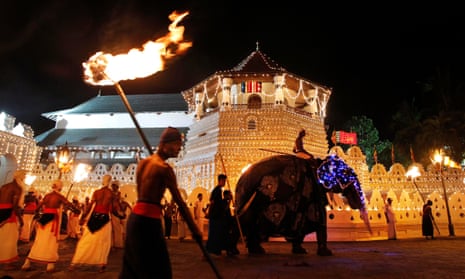
Kandy in the spotlight: war behind it, Sri Lanka's second city sees a tourist boom
The cultural capital of Kandy – controversial location for Indiana Jones and the Temple of Doom – survived Sri Lanka’s civil war relatively intact. Now it’s thriving, thanks in no small part to an infamous relic: one of the Buddha’s teeth
On a hill directly above Kandy there is a statue of Buddha in a seated posture, palms on his lap, signifying meditation. This is far from the most important shrine in this Buddhist-majority city, or indeed an unusual sight in Sri Lanka – the country is peppered with polished white or golden statues that are visible from afar, distinctive amid vegetation. Nonetheless, its proximity to Kandy makes it a good point from which to contemplate the city – and a highly Instagrammable one.
On a scorching spring afternoon, western tourists snapped photos under the indifferent eye of Buddhist monks, while one could hear distant religious chants mixed with the sounds of 90s European dance hits at a party – a scene that pretty much represents the vertiginous change happening in Sri Lanka which, less than a decade after the traumatic civil war ended, is experiencing a tourism boom.
The Buddha’s tooth
Right at the heart of the island, Kandy is the second largest city in the country after the capital, Colombo, but feels like a small town. The city officially has a population of around 125,000, according to the latest registered census in 2012, but the number has probably increased greatly. Spread out around a lake and surrounded by mountains, it is a historically significant city and arguably the country’s cultural capital: its spectacular Temple of the Sacred Tooth Relic, in which is enshrined a tooth of the Buddha – the country’s most important Buddhist relic.
The tooth is precisely the reason for the 10-day elaborate multi-procession festival happening in the city this week, Kandy’s Esala Perahera , in which a replica of the relic is paraded around the city. After six relatively modest days, proceedings escalate on the last four, culminating on the night of the poya (full moon) with thousands of Kandyan dancers and drummers, dozens of elephants dressed trunk-to-toe, colourful banners and more, in Kandy’s biggest night of the year and Sri Lanka’s most striking celebration.
The city in numbers …
500 - altitude in metres; referred to as the “hill capital,” it is itself surrounded by mountains and by the country’s extensive tea plantations.
1815 - year the last Sinhalese kingdom, of which Kandy was capital, fell to the British (after resisting the Dutch and the Portuguese for three centuries).
50 - approximate number of elephants that parade during the Esala Perahera . The number has been as high as 100.
… and pictures
This article includes content provided by Instagram. We ask for your permission before anything is loaded, as they may be using cookies and other technologies. To view this content, click 'Allow and continue' .
Kandy in sound and vision
Kandy’s most memorable cinematic appearance is on Indiana Jones and the Temple of Doom. After the Indian government reportedly found the script offensive – not without reason – the location was switched to Kandy (and England). The fictional Mayapore village, theoretically in North India, was actually filmed in a government-owned tea plantation three miles from the city, and the infamous rope bridge was built and destroyed on the nearby Victoria Dam.
History in 100 words
Kandy dates back to the early 13th century, when the ancient kingdom of Polonnaruwa collapsed and the Sinhalese people moved south. When the rest of the island fell to the Portuguese in 1505 (and, later, the Dutch), the Kingdom of Kandy maintained its grasp on independence, protected by its location in the steep hills in the middle of the country. It wouldn’t lose it until the British invaded in 1815. This isolation gave it an inward-looking, conservative character it preserves to this day.
The same inaccessibility largely protected it from suffering during Sri Lanka’s civil war. Unlike Colombo, Kandy only suffered one significant LLTE attack, a bomb outside the Temple of the Tooth which killed 17 people. Modern Kandy has continued to grow, with urbanisation sprawling up the surrounding hills, especially after the civil war ended and tourism skyrocketed.
What’s everyone talking about?
The Buddhist festival is monopolising attention this week, but more generally, Kandyans are concerned about urbanisation, which is visibly spreading in the surrounding hills, and the resulting congestion and pollution. Kumar Lopez, CEO at the Sri Lankan press institute, says the city’s daily life and even the environment have “drastically changed” since the tourism boom started. “The cool breeze Kandy was known for is gone, and the city has become humid like Colombo.”
For now, tourism seems to be regarded as an opportunity, with hotels and small businesses popping up all over town. People are also talking about the country’s dengue outbreak . Tanya Perera, who runs a B&B in the city, says this has been a unanimous concern among guests.
What’s next for the city?
The government is building a 115km four-lane highway between Kandy and Colombo, which is expected to cut the driving time from its current 3-4 hours. Its 200 billion rupees (£1bn) cost has been part-funded privately, with Chinese assistance . Many in the region hope the road will revitalise the entire central area of the country and give Kandy a true “second city” status.
Travellanka is a complete online guide to the city, but you’re better off chatting to locals if you want to get under the skin of the city. National newspapers include the Sunday Times and the Sunday Observer .
Do you live in Kandy? What have we missed? Tell us below or follow Guardian Cities on Twitter and Facebook to join the discussion, and explore our archive here
- Cities in the spotlight
- Sri Lanka holidays
- South and central Asia

Sri Lanka's perfect, crispy-edged snack – Appam

Sri Lanka’s best food and where to eat it

Savour Sri Lanka: sights, sunshine and beaches – away from the crowds

Places to go in Sri Lanka: readers’ travel tips

Sri Lanka's best new hotels, hostels and cottages

Yoga in Sri Lanka: from here to serenity

Tropical retreat: surfing and yoga in Sri Lanka
Comments (…), most viewed.
Journey of a Thousand Memories
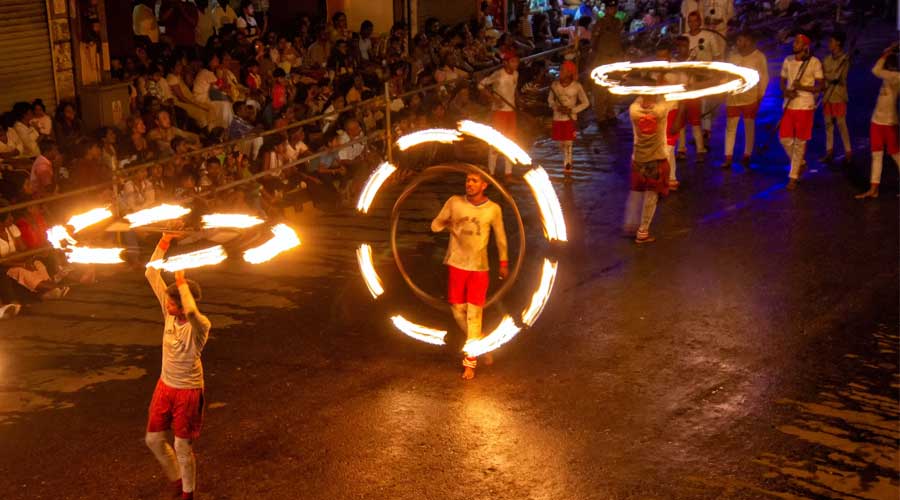
Kandy Esala Perahera
Kandy Esala Perahera: Unveiling the Splendor of Sri Lanka’s Grand Festival
The Kandy Esala Perahera is a vibrant and captivating cultural extravaganza that takes place in the city of Kandy , Sri Lanka. Regarded as one of the grandest and most significant festivals in the country, it combines religious devotion, historical traditions, and stunning pageantry. Lasting for ten nights, the Esala Perahera is a spectacle that draws thousands of locals and tourists alike, creating an unforgettable experience. This article delves into the history, significance, and elements that make the Kandy Esala Perahera an unparalleled celebration, offering insight into the rich cultural heritage of Sri Lanka.
Historical Background
The Origins of the Kandy Esala Perahera:
The genesis of the Kandy Esala Perahera can be traced back to the 4th century BCE, during the reign of King Kirthi Sri Meghavarna. It is believed that the Perahera, in its early form, was an ancient ritual performed to invoke rainfall and prosperity. Over time, the Perahera became intrinsically linked to Buddhism, incorporating elements of the sacred Tooth Relic of the Buddha, which was brought to Sri Lanka from India in the 4th century CE.
The Arrival of the Tooth Relic in Kandy:
In the 16th century, Kandy became the last bastion of independent Sri Lankan kingdoms, as the maritime colonial powers exerted control over other regions. It was during this period that the sacred Tooth Relic found its way to Kandy. In 1595, after numerous relocations, the Tooth Relic was enshrined in the newly constructed Temple of the Tooth (Sri Dalada Maligawa) in Kandy, under the patronage of King Vimaladharmasuriya I. This pivotal event marked the beginning of the Kandy Esala Perahera as an annual procession.
The Development of the Kandy Esala Perahera:
During the reign of King Rajasinghe II (1635-1687), the Perahera gained prominence and grandeur. The king initiated significant improvements to the procession, expanding its scale and introducing diverse cultural elements. The Perahera began to feature elaborately adorned elephants, drummers, dancers, fire performers, and various other traditional performers. King Rajasinghe II’s contributions played a vital role in transforming the Perahera into the magnificent spectacle we witness today.
Symbolism and Significance:
The Kandy Esala Perahera encompasses profound symbolism and spiritual significance. The majestic tusker carrying the golden casket, which houses the sacred Tooth Relic, symbolizes the protection and prosperity of the nation. The Perahera acts as a conduit between the people and the divine, fostering religious devotion, cultural unity, and social harmony among diverse communities in Sri Lanka. It also serves as an essential platform for passing down traditional arts and crafts from generation to generation.
Challenges and Preservation:
Throughout history, the Kandy Esala Perahera faced numerous challenges, including colonial suppression and cultural assimilation attempts. Yet, it persevered and endured, with successive generations of Sri Lankans dedicated to its preservation. In 1980, the Perahera was inscribed on UNESCO’s Representative List of the Intangible Cultural Heritage of Humanity, recognizing its exceptional value to the world.
Significance and Religious Importance
Religious Significance:
The Kandy Esala Perahera holds profound religious significance for Buddhists. The sacred tooth relic, believed to be one of the Buddha’s teeth, is enshrined within the Temple of the Tooth (Sri Dalada Maligawa) in Kandy. During the Perahera, the relic is placed upon a majestic tusker, adorned with richly decorated attire, and paraded through the streets. This procession symbolizes the power of Buddhism and the importance of protecting and venerating the sacred relic.
Rituals and Ceremonies:
The Perahera spans several nights, each filled with diverse rituals and ceremonies. The opening ceremony, known as “Kap Situveema,” involves planting a sanctified young jackfruit tree to signify the commencement of the festival. This is followed by the ‘Kumbal Perahera,’ a series of nightly processions featuring whip-crackers, drummers, flag bearers, and traditional dancers. As the festival progresses, the intensity and grandeur reach their peak during the final nights, known as the ‘Randoli Perahera.’ The streets come alive with elaborately costumed performers, fire dancers, acrobats, and a multitude of caparisoned elephants.
Among the various captivating elements of the Kandy Esala Perahera are the Diya Kepeema and Day Perahera, two mesmerizing events that exude a unique charm and spiritual significance. Let us delve into the enchanting world of Diya Kepeema and Day Perahera, and explore the magic they bring to the grand festivities.
Diya Kepeema: The Illuminated Spectacle
Diya Kepeema, which translates to “the ceremony of lighting lamps,” is a breathtaking display of illuminated creativity. This event takes place several nights before the main Kandy Esala Perahera and sets the stage for the grandeur that follows. During Diya Kepeema, the sacred Temple of the Tooth Relic and its surrounding areas are adorned with thousands of oil lamps, creating a resplendent spectacle that illuminates the night sky.
The Diya Kepeema ceremony holds deep spiritual significance. The lighting of the lamps symbolizes the dispelling of darkness and the arrival of light, both literally and metaphorically. The glowing lamps represent the devotion of the people towards Lord Buddha and the hope for a bright future. As the golden light flickers against the backdrop of the sacred temple, it creates an ethereal ambiance that fills the hearts of onlookers with tranquility and awe.
Day Perahera: The Majestic Procession
The Day Perahera is a vibrant daytime procession that forms an integral part of the Kandy Esala Perahera. It takes place on the final day of the grand festival, marking the pinnacle of the celebrations. The Day Perahera features a multitude of captivating elements, including beautifully adorned elephants, traditional dancers, musicians, fire breathers, whip crackers, and flag bearers.
At the forefront of the Day Perahera is the magnificent Maligawa Tusker, the most revered elephant of the Sacred Temple of the Tooth Relic. Adorned in elaborate regalia and draped in colorful fabrics, the tusker carries the sacred relic casket, which is the focal point of veneration during the procession. The elephant’s majestic presence, combined with the rhythmic beats of drums and the melodious tunes of flutes and trumpets, creates an atmosphere of grandeur and spiritual fervor.
As the Day Perahera progresses through the streets of Kandy, spectators are treated to a sensory feast. Dancers sway gracefully, depicting traditional rituals and cultural tales, while fire performers amaze the crowd with their daring acts. The vibrant costumes, intricate masks, and exquisitely crafted floats add to the visual splendor, showcasing the diverse cultural heritage of Sri Lanka.
The Significance and Unity of Diya Kepeema and Day Perahera
Diya Kepeema and Day Perahera hold immense cultural and religious significance. They bring together people from all walks of life, transcending social barriers, as devotees and spectators alike immerse themselves in the spiritual ambiance of the festivities. These events foster a sense of unity and communal harmony, emphasizing the shared heritage and traditions of Sri Lanka.
The Kandy Esala Perahera, with its captivating Diya Kepeema and majestic Day Perahera, serves as a testament to the rich tapestry of Sri Lankan culture. It is a celebration of faith, devotion, and the artistic prowess of its people. Visitors who witness the spectacle are left with indelible memories of a truly unique experience, one that ignites the imagination and touches the soul.
Cultural and Artistic Splendor:
Beyond its religious importance, the Kandy Esala Perahera showcases Sri Lanka’s rich cultural heritage. The procession features a kaleidoscope of traditional dancers performing various forms of dance, such as Kandyan, Sabaragamuwa, and Udarata. The rhythmic beats of drums, the resounding sounds of conch shells, and the melodic tunes of flute players create an enchanting atmosphere. The Perahera is also an opportunity for artisans and craftsmen to showcase their skills, with beautifully crafted costumes, jewelry, and decorative ornaments adding to the visual spectacle.
Community Participation and Devotion:
The Kandy Esala Perahera is not only a religious event but also a celebration that unites communities across Sri Lanka. Devotees from all walks of life gather to witness the procession, offering their prayers and seeking blessings. Many families engage in religious observances, including fasting and participating in acts of merit, as a mark of devotion. The Perahera also attracts a significant number of tourists, who are captivated by the grandeur and spiritual aura of the event.
Preparations and Rituals
Months before the Esala Perahera, extensive preparations are made to ensure its smooth execution. The organizing committee, comprising religious leaders, officials, and volunteers, meticulously plans the event. Elaborate costumes, intricately designed decorations, and beautifully adorned elephants are prepared to dazzle the spectators.
The festival begins with the Kap Situveema, a ritual that plants a sanctified young jackfruit tree within the premises of each devale (shrine). This ritual signifies the announcement of the forthcoming Perahera. Following this, a series of religious observances and ceremonies take place, including the planting of young coconut plants and the distribution of herbal preparations to elephants.
The Grand Procession
The highlight of the Kandy Esala Perahera is the grand procession that parades through the streets of Kandy for ten consecutive nights. The procession features various cultural elements and meticulously choreographed performances, creating a mesmerizing spectacle.
The Perahera begins with whip-crackers clearing the way, followed by flag bearers representing each devale. Drummers set the rhythm, while traditional dancers perform intricate routines. Fire dancers, acrobats, and stilt walkers add an element of excitement and skill to the procession.
The majestic tuskers, adorned with vibrant costumes and intricate ornaments, are the center of attention. The Maligawa Tusker, carrying the sacred tooth relic casket, is the most revered among them. As the procession advances, devotees offer flowers, light lamps, and chant prayers, seeking blessings and protection.
Cultural Significance and Tourism
Cultural Showcase:
The Kandy Esala Perahara is a captivating showcase of Sri Lankan culture and traditions. The processions include various dance forms such as Kandyan dances, fire dances, whip dances, and drumming ensembles. These performances display the diversity and vibrancy of the country’s artistic heritage, captivating both locals and visitors alike. The intricate handcrafted costumes, vibrant masks, and elaborate headpieces worn by the dancers reflect the unique craftsmanship and attention to detail that has been passed down through generations.
Tourism and Economic Impact:
The Kandy Esala Perahara has emerged as a major tourist attraction, drawing thousands of visitors from across the globe. Tourists flock to Kandy during this festival to witness the grandeur and immerse themselves in the cultural ambiance. The influx of visitors provides a significant boost to the local economy, benefiting the hospitality industry, transportation services, and handicraft vendors. Additionally, the increased exposure of Sri Lanka’s cultural heritage through the festival helps promote the country as a prime destination for cultural tourism.
Preservation and Challenges:
While the Kandy Esala Perahara continues to thrive and captivate audiences, preserving its authenticity and cultural significance poses challenges. The delicate balance between tradition and modernity, as well as the need to ensure the ethical treatment of elephants involved in the processions, are ongoing concerns. Efforts are being made to address these challenges by incorporating sustainable practices, promoting animal welfare, and safeguarding the cultural heritage associated with the festival.
Related Posts
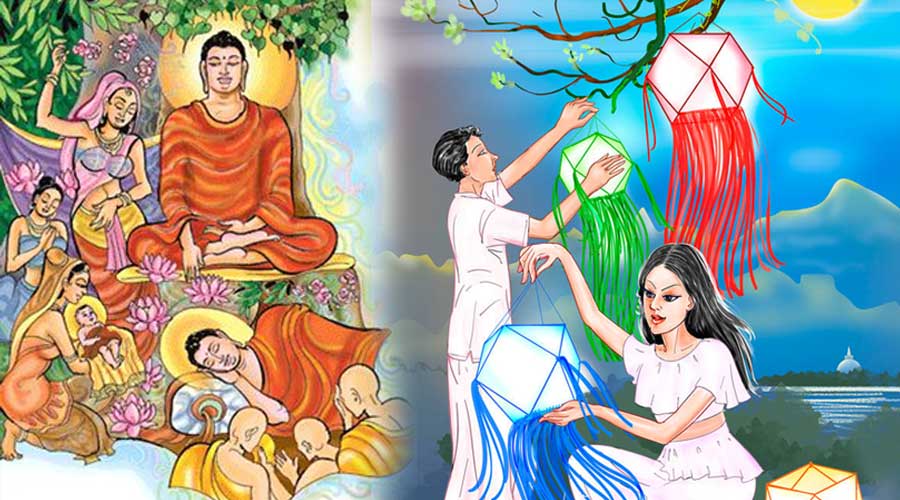
Vesak Poya Day

Esala Full Moon Poya Day
[…] cultural festivities in countries like Sri Lanka. The highlight of these celebrations is the Esala Perahera, a grand procession held in Kandy. It features beautifully decorated elephants, traditional […]
Leave a Reply Cancel reply
Your email address will not be published. Required fields are marked *
Save my name, email, and website in this browser for the next time I comment.

- August 1987
- September 1987
- October 1987
- November 1987
- December 1987
- January 1988
- February 1988
- August 1988
- September 1988
- October 1988
- November 1988
- December 1988
- January – March 1989
- January 2010
- February 2010
- August 2010
- September 2010
- October 2010
- November 2010
- December 2010
- January 2011
- February 2011
- August 2011
- September 2011
- October 2011
- November 2011
- December 2011
- January 2012
- February 2012
- August 2012
- September 2012
- October 2012
- November 2012
- December 2012
- January 2013
- February 2013
- August 2013
- September 2013
- October 2013
- November 2013
- December 2013
- January 2014
- February 2014
- August 2014
- September 2014
- October 2014
- November 2014
- December 2014
- January 2015
- February 2015
- August 2015
- September 2015
- October 2015
- November 2015
- December 2015
- January 2016
- February 2016
- August 2016
- September 2016
- October 2016
- November 2016
- December 2016
- January 2017
- February 2017
- August 2017
- September 2017
- October 2017
- November 2017
- December 2017
- January 2018
- February 2018
- August 2018
- November 2018
- December 2018
- January 2019
- February 2019
- August 2019
- September 2019
- October 2019
- November 2019
- December 2019
- January 2020
- February 2020
- September 2020
- October 2020
- November 2020
- December 2020
- January 2021
- February 2021
- August 2021
- September 2021
- October 2021
- November 2021
- December 2021
- January 2022
- February 2022
- August 2022
- September 2022
- October 2022
- November 2022
- December 2022
- January 2023
- February 2023
- August 2023
- September 2023
- October 2023
- November 2023
- December 2023
- January 2024
- February 2024
- WHAT’S ON
- FOR DIGITAL SUBSCRIPTION

INSPIRING FUSION OF TRADITION AND CULTURE KANDY ESALA PERAHERA

The Dalada Perahera, as it was originally called, commemorates the time the Buddha’s sacred tooth relic was first brought to Sri Lanka from India. It allows devotees to venerate the Tooth Relic as it is carried through the streets in a casket on the back of a magnificent tusker elephant.
It is the pageant of the Sri Dalada, replete with all the pomp of ceremony and the sacredness of worship as befits the occasion when a nation pays homage to the founder of her religion, Buddhism. Even as it has been done for over 200 years, every year the Tooth Relic of the Buddha is taken in procession for nine nights through a four mile route on the streets of Kandy. But the colorful story of the Sri Dalada, Sri Lanka’s most special parade and its annual procession, occupies a more extended passage in the annals of history. In fact, its origins lie over 1,700 years ago when it was brought to the nation’s shores. The Tooth Relic had not only been accorded annual royal pageants to honor its presence in Sri Lanka, but it had also come to embody the possessor of it with the legitimacy to be king of Lanka. With the fall of the 1,400-yearold ancient capital of Anuradhapura in 10 AD in the face of a Chola invasion from South India, the Sinhala kingdom moved to Polonnaruwa. So did the Tooth relic. With each successive debacle that followed and with each subsequent retreat the Sinhala kings made, with each shift of the Sinhala capital to safer ground southwest, so did the sacred relic travel on the kingdom train until at last it was lodged in the Kingdom of Kandy by King Vimaladharmasuriya II (1686-1707 AD). He built the Temple of the Tooth, the Dalada Maligawa, and enshrined the sacred relic in it.
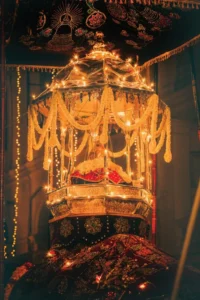
In the late 18th Century, the old practice of the yearly road pageant was revived by King Kirthisri Rajasinghe, and this has continued ever since. At that time, there were already in existence four peraheras, collectively called the Esala Perahera, dedicated to the nation’s guardian deities. These were held to invoke the help of the deities of the four Devales for victory in war and success in secular undertakings and to seek blessings of the gods to bestow farmers with rain to cultivate their crops. Today it is considered to be the main significance of the Esala Perahera. The Esala Festival covers 14 days and begins on the first day after the new moon in August. For five nights in the four Devales, processions are conducted within the temple premises with flag bearers, drummers, and torchbearers. On the sixth night, the four temple peraheras emerge from their temple compounds and take to the street. This is the start of the procession known as Kumbal Perahera, held for five more nights. The four peraheras converge at the Temple of the Tooth Relic, where the Dalada Maligawa Perahera joins the pageantry. Initially keeping a low key, with the temple chiefs wearing only their traditional white court dress to walk in the procession, more and more elephants are added to the perahera with each succeeding night. On the eleventh night, the perahera bursts into a rhapsody of color to express devotion’s ecstatic enthusiasm. Called the Randoli Perahera on accounts of the palanquins added to the procession, which in the days of old, bore queens from the royal household, it is staged for the next four nights and will climax on the full moon night of August. After the cannonball boom and the conch shell blast have resounded, and the whip crackers have cleared the streets, the flag bearers step forth in single file, each carrying the standard of different provinces and temples. At the helm of the gathered cast assembled at the main temple, gate is the Peramuna Rala, a Kandyan chief-tain representing the administration of the entire gamut of the ‘Rajakariya’ – the feudal system. Sitting astride a caparisoned elephant, he begins the procession at the auspicious hour. He is attired in the traditional Kandyan costume, and he carries in his hand the silver metallic cylinder bearing the all-important sannasa, called Lekam Mitiya. The royal title deed and edict pertaining to all the lands bestowed and the duties of each holder of the land have to be discharged in favor of the temple at the risk of forfeiture.

The richly garbed elephant he strides on belongs to the royal elephant stables. The man following his atop another elephant is the one charged with the responsibility for the welfare of all the king’s elephants. He is known as Gaja Nayake, the keeper of tamed elephants. His jacket is rich in embellishments and red in color and bears ancient motifs of the Sri Lankan kingdom. His matching waistcoat is the same color and design as is his curved headdress, and he brandishes the henduwe or ankusala, the silver goad used to control the elephant.

Drums and dance to enthrall the watching devotees with the magic of movement and music enter the frame. First to come is the Hewisi, the men who, with their high-pitched flutes known as horannawes, once traditionally served as the royal announcers at momentous occasions. Wearing white cloth wrapped tightly with a broad red slash, which extends up to their chests, are also the Thammettam drummers who use a set of twin drums with two curved cane drum sticks. Bedecked elephants, in vivid and varied hues, start appearing in twos or threes at regular intervals. While they swing rhythmically to the beat of the tantalizing drums, joining the parade are the flame throwers, forming a fiery ring with their fire torches around their bodies with a dexterity born of practice. Accompanying them are the Raban dancers. Twirling the Raban, a circular shaped drum, with one hand, they then deftly place it on the many slender poles they hold in their other hand. As their confidence rise, they raise the thin poles with the spinning raban on top and place it on their heads. They put one end of the pole into the tuft in their headwear and sway and dance hands-free to the sound of the beating drums.
It’s now the turn of the Uddekki dancers who get the name of the musical instrument they use. It’s a small hand drum in the shape of an hourglass about seven inches in length. The sides of the percussion instrument both bear drum skin. To obtain pitch variations, the strings are tightened, and the drummer dances while he plays it, and on top of it, he also sings. The Uddekki dancer is dressed in a silver color beaded jacket, which winds around his neck. He wears elaborate frills in red at the waist. His headwear consists of a white turban with a colorful gold colored border. Bracelets and amulets are worn on his wrists and arms. Next is the turn of the Pantheru dancers, bearing one of the oldest instruments in the music business. It is a tambourine minus the drum skin, with small cymbals attached around its circumference. It is held in one hand, and it is played by shaking it or striking it with the other hand making a jingling sound of metal clinking. The myth has this as the one used by the Gods to celebrate their battlefield victories over the Asuras, the demons. Following suit on earth, Sinhala kings used to jangle it to raise the triumphant cry over their enemies in war.

Now hugging the firelight shed by the flare bearers who stand like street lamps are the crème de la crème: the Ves Dancers performing the hallmark of Kandyan dancing at its best. Of all the dance troupes, the Ves dancers approach their art with religious fervor and treat it with religious respect. They dance in honor of the Sri Dalada with their bodies facing the venerated object, singing as they do the many hosannas while dressed in an elaborate costume containing over 16 different parts. The most essential item in the regalia without which the dancer loses his legitimacy to dance the sacred dance of Ves is the Ves Thattuwa. Made out of silver and brass, its engraved designs symbolize the Sun, Buddhism, the Gods, and Kings and bear thirteen brass bo leaves, which hang dangling from ear to ear. Following behind the extravaganza of dance is the Kariya Karawana Korale. He is the man who bears on his costumed puffed shoulders the entire responsibility of the pageant and is the second most important man after the Diyawadana Nilame. He is also responsible for the proper functioning of the Dalada Maligawa, including the kitchen. As he walks in the perahera, he is accompanied by a retinue of temple functionaries, dancers, and drummers. Amidst the song and dance, next comes the moment when the sacred object of a people’s faith, the nation’s priceless treasure, the sacred Tooth Relic of the Buddha. Enshrined in a golden casket and borne aloft on the back of a majestic tusker, takes center stage on the public road before the worshipful gaze of a devout public. Its holy presence stills the air with serenity. It invokes the full gush of reverence, giving rise to a roar of ‘sadhu, sadhu, sadhu – expressions of spontaneous adoration as the sacred faith enshrined in a people’s heart freely breaks out.
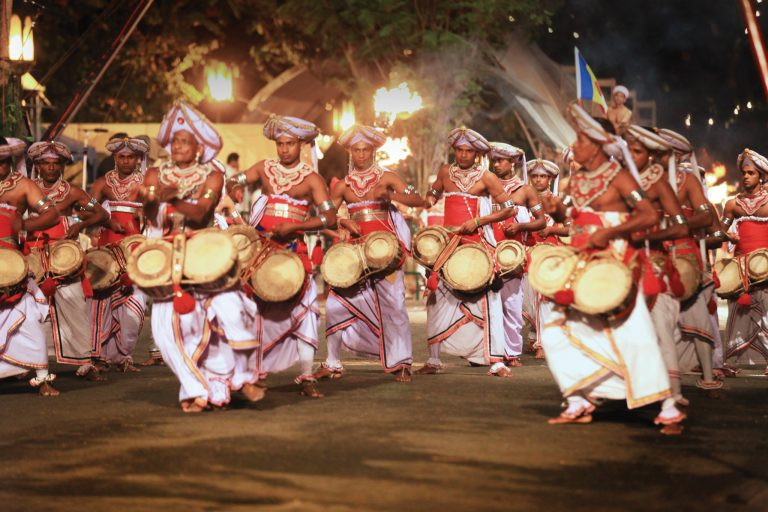
Enthralling performances by the dancers and drummers are part of the grand pageant.

Before the public, the tusker proudly stands, swaying gently to the rhythm of the music adorned with a golden garb encrusted with hundreds of luminous beads that glitter in the spotlight. For many years now, the Tooth Relic has not been taken out due to security and other reasons. What is paraded today is the replica of the casket but still does not diminish the fervor of the spectators, for faith transcends reality, and belief reign supreme.
Walking behind the casket bearing the tusker is the Kavi maduwa, descendants of the poets of old who entertained the king with poetry, art, and wit. They formed the king’s art circle, the Royal literati. Following the Kavi Maduwa walks the conductor of the entire perahera orchestra, the man of the hour; the Diyawadana Nilame. He is dressed in his Randoli best, the colorful and formal Mul Adhuma. His power as the sole arbiter ceases the moment he disrobes his costume, and the old saying ‘clothes maketh man’ applies to him literally, for, without his uniform, he is like Samson shorn of his air. Another troupe of Ves dancers is now before him dancing in his honor as their forefathers used to dance before the king two hundred years ago. They perform the same dance, follow the same motions and sing and dance their vannams facing him as he approaches. Behind the Nilame comes the Gam Vidanas, the village heads. With the last of the Gam Vidanes passing by, it signals the end of the Sri Dalada Perahera. But still, the entire pageant is not yet over.
In the trail of the Sri Dalada follow the four peraheras of the nation’s four guardian deities. The first perahera to come is the perahera dedicated to God Natha. God’s color is yellow, and the elephants are all dressed in yellow. This perahera is followed by the perahera of God Vishnu, and the color blue now pervades the scene. Next is the perahera dedicated to God Kataragama, and the elephants and the participants are dressed in red. The last perahera is devoted to Goddess Paththini whose color is translucent and represented by the color white. No female dancer is allowed to perform in any of the peraheras. Still, in the Paththini perahera, since the deity is female, an exception has been made, and women dancers join in on the act.
The Kandy Esala Perahera is a grand pageant that showcases the island’s millennia-old traditions and customs. It represents the legacy of the Dalada Vahansa in Sri Lanka and the great dedication of her people to protect and worship the Sacred Relic.
exploresrilanka.lk EXPLORE SRI LANKA | AUGUST 2021
Explore Sri Lanka March 2024
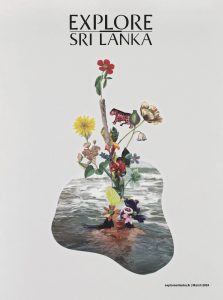
- Terms & Conditions
- Privacy Policy
© 2023 BT Options. All Rights Reserved.
Awesome, you're subscribed!
Thanks for subscribing! Look out for your first newsletter in your inbox soon!
The best things in life are free.
Sign up for our email to enjoy your city without spending a thing (as well as some options when you’re feeling flush).
Déjà vu! We already have this email. Try another?
By entering your email address you agree to our Terms of Use and Privacy Policy and consent to receive emails from Time Out about news, events, offers and partner promotions.
Love the mag?
Our newsletter hand-delivers the best bits to your inbox. Sign up to unlock our digital magazines and also receive the latest news, events, offers and partner promotions.
- Things to Do
- Restaurants & Cafes
- Bars & Pubs
- Art & Culture
- Explore Sri Lanka
- Los Angeles
Get us in your inbox
🙌 Awesome, you're subscribed!

The Kandy Esala Perahera
Step into the hill capital of Kandy this August to witness the grand spectacle of the Esala Perahera as it parades the streets in a whirl of colour, culture and pomp
It is that time of the year again where Kandy becomes the centre of attention holding everyone captive in its grasp as the entire town takes on a vibrant note to herald the Kandy Esala Perahera. Countless visit the town centre, and buildings around the town join in the festivities with colourful decorations. It is truly a festive time!
An email you’ll actually love
August 20-24, 2015 Kumbal Perahera
August 25-30, 2015 Randoli Perahera
August 30, 2015 Day Perahera (Water Cutting Ceremony "Diya Kepeema")

Bit of history
The origin of the Esala Perahera goes as far back as the third century BC. However, the current procession has been held annually since the time of King Kirthi Sri Rajasinghe (1747-1781). The intent of starting the perahera was to provide the general public with an opportunity to pay homage to the tooth relic of Lord Buddha, which was otherwise kept under lock and key as the sole property of the King. The perahera line-up comprise according to the complex practice of the ‘Rajakariya’ or the feudal duty system, which was solely based on the mutual goodwill of the respective officers who reaped certain benefits from the lands belonging to the temple.

The beginning
Beginning of the perahera is ushered by the kap situveema, planting of a sanctified Jak tree. Afterwards, for five days a series of processions will be conducted at the four devalas of the four guardian deities of the island, namely Natha, Vishnu, Kataragama and Paththini. These parades will be restricted to the confines of each devalaya and is named the ‘devala perahera’, as it does not go beyond the temple premises.
However, once the perahera starts to parade beyond the temple grounds, countless devotees and spectators gather to the sides of the streets to witness the pageant and in order to get a prime spot it is better to go early in the day to save a place. However, if you are planning on purchasing tickets to one of the many seating areas, it is better to do so well in advance.

Kumbal Perahera
It is after these initial five days, that the true spectacle starts and it is nothing but 10 days of cultural extravagance to tickle the fancy of any culture buff. The first five days of the pageant is dedicated to the Kumbal Perahera, which parades across a limited number of streets. Usually the first night of the Kumbal Perahera is deemed as the most significant and many devotees bring their children along to ward off evil spirits and ill will that may have fallen on them.

Randholee Perahera
The sixth night gives way to the Randholee Perahera, a grander version of the Kumbal Perahera with many more dancers and elephants where at the end of the procession seven palanquins are carried. These palanquins or Randholee are said to represent the traditional mode of transport of Queens in ancient Sri Lanka.
The last day of the Randholee Perahera, which usually falls on a Poya day is the grandest of all and is paraded through almost every street of the town.
As dusk falls, the temple premises bustles with last minute preparations as dancers, elephants and officials all take their respective places in the perahera. At the auspicious time, a cannon shot is fired to signal that the eagerly awaited pageant has started its journey.

And the procession goes on
The whip crackers lead the way with their ‘snake whips’, and with each crack of the whip the excitement builds up. It is the duty of whip crackers to clear the streets of human and animals so that the perahara can proceed without any hindrance. In keeping with the tradition, men carrying burning copra baskets (wire baskets filled with dried pieces of coconut husks), walk slowly along the sides illuminating the pageant. Conch shells are also blown at the same time, signaling the upcoming acts.
Then follows a swirl of colour, animation, exhilaration and most of all tradition! Fire dancers, elephants, numbering more than 100, all dressed in colourful attire, dancers keeping in time to the beat of the drummers and officials sitting majestically on elephants make way for a cultural extravaganza unlike any. The highlight of the perahera is the main tusker carrying the golden casket, ushered through by Ves dancers performing traditional Kandyan dances. As the tusker, all decked in its finest, passes by people would stand and chant ‘Sadu Sadu’ paying homage to Lord Buddha. Soon after, Diyawadana Nilame, chief of the Temple of the Tooth along with his entourage follows signaling the end of the perahera of the Dalada Maligawa. But that is not the end of the pageant as the four devala peraheras dedicated to the four guardian deities of the island— gods Natha, Vishnu, Kataragama and goddess Paththini accompany the Esala Perahera. Each of the peraheras take on the representative colours of the gods—yellow, blue, red and again yellow (to showcase the translucent colour of the goddess).
Once the pageant has toured the streets, another cannon shot is fired to announce that the perahera has entered the premises of the temple, concluding yet another year of tradition.
Dawal Perahera
However, the next day yet again people gather on to the streets, to watch the day (dawal) perahera as it makes its way to Getambe to perform the water cutting ceremony, officially ending the Esala Perahera for the year.
While you wait for the perahera to starts
While you wait for the night to come with bated breath, keep yourself occupied and take some time to explore the town of Kandy or even venture beyond the town limits to discover some amazing sites.
See ten things to do in Kandy .
Where to stay
Looking for a place to stay, check out our suggestions for some of the best accommodation options in Kandy .
[image] [title]
Discover Time Out original video
- Press office
- Investor relations
- Work for Time Out
- Editorial guidelines
- Privacy notice
- Do not sell my information
- Cookie policy
- Accessibility statement
- Terms of use
- Modern slavery statement
- Manage cookies
- Advertising
- Time Out Market
Time Out products
- Time Out Worldwide
- Book Reviews
- Pictorial Images
- Sinhala Mind-Set
- Speeding Up Links: Mirigama-Kurunegala Expressway Soon Operational
- Why Thuppahi
- Young Tourism Ambassadors in Jaffna

The Kandy Äsala Perahära by Lorna Dewaraja
Tissa Devendra, in The Island, 3 October 2018, with this title “ Mirror of Civilisation” b eing a book review of The Kandy Asala Maha Perahera – by Dr.Lorna Dewaraja (Vijitha Yapa Publications 2018)

In publishing this fine book, Vijitha Yapa has faithfully fulfilled the last wish that Dr. Dewaraja expressed to her family – to hand over to Vijitha Yapa the manuscript of her book on the Kandy Perahera. I now have the privilege of reviewing this publication.
I have had the great good fortune to have spent my boyhood in Kandy, enthralled by the magnificent Perahera as it paraded in front of our home in Cross Street. My scholarly father gave us children a ‘running commentary’ on the various aspects of the Perahera, from the lordly Gajanayaka Nilame astride his giant elephant, the significance of the various devales, the different bands of drummers, the noble palanquins carried shoulder-high at Randoli Peraheras followed by a group of traditional women devala attendants. We children were more interested in counting the gloriously caparisoned elephants, admiring the nilames’ stately gait swathed in bejeweled splendor, swaying to the mesmerizing rhythms of the corps of drummers. I must confess that to us youngsters the Perahera was just a wonderful spectacle – not a lecture demonstration of Kandyan history.
Professor Lorna Dewaraja, perhaps the most authoritative historian of the Kandyan Period, has in this, her last, book while delving deep into the origins and traditions of the Asala Perahera, gives readers a fine account of the life, times, and culture that prevailed in the royal kingdom of Sinhale during its last phase.
The early chapters reach back to the ancient kingdom of Anuradhapura, the arrival of the Sacred Tooth Relic of the Buddha – the Dalada –and its early adoption as the palladium granting legitimacy to the kings of the Sinhala Kingdom. It is noteworthy that, from the very beginning, there took place regular Peraheras to honour the Dalada. The Mahavamsa records that during the reign of Parakramabahu IV (1325) “Dancing girls performed delightful dances and sang songs” at the grand festivals to honour the Tooth Relic. These glorious processions have been vividly described by such foreign observers from centuries ago as Chinese Buddhist scholar-pilgrim Fa Hien and, centuries later, English prisoner Robert Knox, of extraordinary memory. Interestingly, our own chronicles also record that these Peraheras also featured women dancers. However, neither a Perahera honouring the Dalada nor women dancers feature in later accounts of Sinhala ceremonies during the Colonial period. I venture to suggest that this may have been a precautionary measure not to draw the invaders’ attention to the Dalada which had to be protected as the symbol of Sinhala kingship.
However, the Sinhala people loved Peraheras but seem to have shifted their emphasis from the Dalada (now in hiding) to the galaxy of deities they shared with Hinduism – though with Sinhala variation. These deities were Vishnu, Natha, Kataragama. Pattini — all connected with shamanistic practices and deeply embedded pre-Buddhist fertility rituals. The Kings of the Kandyan Kingdom encouraged the establishment of ‘devalas’ to these deities, within the precincts of the royal capital – where they yet flourish and are an integral component of the Perahera.
Portuguese hegemony and persecution of Buddhism in the Maritime areas led, inevitably, to the decline of Buddhism in the Kandyan Kingdom as well. The Sangha declined and lost all contact with other Buddhist kingdoms in East Asia. But worship of deities and their shrines flourished. So did their annual Asala Perahera parading the royal city – symbolizing the primordial beliefs and fertility practices of an agrarian society.
Buddhism in the Kandyan Kingdom had a great revival in the 18th century thanks to the learned ‘Samanera’ Welivita Sri Saranankara who persuaded King Kirti Sri Rajasinghe to negotiate with the Dutch rulers of Maritime Ceylon to transport a Kandyan delegation to travel to the Buddhist kingdom of Siam. Its mission was to seek help to re-establish the depleted Buddhist Sangha in the Kandyan Kingdom . The shrewd Dutch fully cooperated, thus scoring a diplomatic trump. The Kandyan delegation was successful and returned with a congregation of learned Siamese Bhikkus. Their great victory was the re-establishment of the Sinhala Sangha in the Sinhala Kingdom of Sri Lanka . Their leader the learned Upali Thera observed that the Sinhalese Buddhists annually held a grand celebratory procession to honor Hindu deities and fertility rituals. But he was deeply saddened that the Royal palladium of the Sacred Tooth Relic had no role in this most glorious procession. He expressed his views to an understanding King and Sangharaja Saranankara that the Dalada had to be give pride of place – as the Buddha and his Dhamma were superior to all deities. The Asala Perahera now was now reorganized as a Dalada Perahera, as in ancient times. The rituals of the Dalada Maligava were now given primacy into the procession and carried the golden casket from the Dalada Maligawa. Dr. Dewaraja gives a comprehensive account of the Maligava rituals, ceremonies and the responsible officials from bards, musicians and ‘alati ammavaru’ to the lay custodian Diyawadana Nilame.
When Kandy was yet ruled by a king, the Perahera also performed a definite political role. It was the traditional gathering of “all the King’s men” – every Chieftain administering the outlying regions, their entourages bearing regional banners had to pay symbolic tribute to the monarch and follow him in the procession . This was a traditional expression, and public display, of loyalty to their King. The chapter on ‘State and Society in the Kandyan Kingdom’ is a scholarly, but readable, account of the Kandyan polity and a comprehensive listing of its officials according to precedence and function. Significantly, this custom yet prevails, though much diluted, when the participant nilames and dancers present themselves to the President of the Republic to announce the successful conclusion of the year’s Asala Perahera.
The chapter on the Randoli Perahera comprehensively describes the composition of the procession, the role of the Nilames, dancers, drummers and, of course, the majestic elephants. This account encapsulates the heart of the book.
Dr. Dewaraja goes on to give an account of the confused history of the Perahera under Colonial rule. In the ‘Kandyan Convention, of 1815 the British, clearly dishonestly, gave a ‘sop’ to the Nilames that “The religion of the Budhhoo is declared inviolable and its rites and ministers anh its places of worship are to be maintained and protected”. The Governor, however, came under attack from Christian missionaries and chauvinistic Britishers who contended that the English monarch, sworn to defend the Christian faith could not also defend a heathen faith. The Governor was, however, acutely aware that as the Asala Perahera was integral to Kandyan Buddhist practice, any interference with it would subvert loyalty to the British ruler. The ill-fated ‘Kandyan Rebellion of1818’ provided the British with the opportunity to ban the Perahara . In spite of intermittent spells of re-establishment, this was a ploy they resorted to whenever there was trouble from Kandyans. The Governor, however, remained legal custodian of the Dalada. At last in 1853 this role was abolished and the Dalada came under the custody of the Kandyan Sangha. Strangely some Kandyans deplored the replacement of royal patronage by mere ‘civilians’!
I now retail a snippet of recent history, regarding the Perahera, that has escaped the historian’s eye. During WW II the Japanese Airforce launched a few bombing raids on the British colony of Ceylon. The colonial government immediately went into war preparation mode. Rice and petrol were rationed, ARP [Air Raid Precautions] were imposed – most importantly – black-outs. No visible lights at night, illuminations banned at places of worship, in company with all other night-time processions the Kandy Perahera was “banned for the duration” as Kandy was Mountbatten’s SEAC HQ, crowded with Allied troops and, therefore, a prime target. The Japanese did not bomb Ceylon again, but the ban remained till Hiroshima ended WW II. The Perahera now emerged from its ‘hibernation’ and , once again, paraded the streets of Kandy in 1946 and continues to this day.
As a true historian Dr. Dewaraja’s narrative continues to the present era. Perhaps the most significant events in this regard were the Service Tenure Ordinance and the Buddhist Temporalities Ordinance of the late Colonial period which began chipping away at the centuries old system by which hereditary peasant clans had been ‘granted’ Temple owned lands and were expected, as tribute or ‘rent’, to perform their traditional (caste) skills [as dancers, drummers etc] at Maligawa functions and Peraheras. The Paddy Lands Act of independent Ceylon was a’ socialist’ law which “freed the peasant cultivator from hereditary land owners” – but almost dried out the flow of experienced dancers, drummers and such artistes into temple functions and processions.

Fortunately, Kandyan culture has proved remarkably resilient. Traditional clans have now established ‘kalayathanayas’ [dance academies] whose trained corps of dancers and drummers now perform at temple functions, peraheras and official functions. Traditional, as well as professionally trained. artistes now teach dance and music at schools and there is now a prestigious University of Visual and Performing Arts. The Army, Navy, Airforce and Police now proudly parade their much admired, corps of traditional musicians and dancers, both women and men.
A fine portfolio of photographs illustrates this admirable account of Sri Lanka’s most ancient and magnificent Sinhala Buddhist festival by Dr. Lorna Dewaraja, our great scholar of the Kandyan Kingdom.
Share this:
Leave a comment
Filed under art & allure bewitching , British colonialism , cultural transmission , education , elephant tales , heritage , historical interpretation , landscape wondrous , life stories , religiosity , self-reflexivity , sri lankan society , the imaginary and the real , travelogue , unusual people , working class conditions , World War II
Leave a Reply Cancel reply
- Campaign to Promote “Malaiyaha Thamilar” Identity
- Boom! Boom! The Central Bank Collapses in Front of Our Eyes!
- Elephant Orphanage & Elephant Lore: Dilmah Initiative at Uda Walawe
- The LTTE Bomb Attack on the Central Bank Building in the Heart of Colombo, 31 January 1996
- Hot Press: Ukraine on the Backfoot in War with Russia
- For Ceylon. Roman Szechowycz in Gal Oya, 1950-61
- Differentiation in the Foundations of Criticism in Recent Struggles in Sri Lanka
- Australia’s Cricket Squads for Forthcoming Seies Announced
- The Crocus Terrorist Attack: Steven Seagal, the Australian Embassy, the Perpetrators and Victim
- Why the West is wrong to blame ISIS for the Crocus Terrorist Attack
- 9/11 Attacks (1)
- Aboriginality (29)
- accountability (3,333)
- Afghanistan (47)
- Africans in Asia (6)
- Afro-Asians (8)
- Al Qaeda (69)
- american imperialism (647)
- ancient civilisations (130)
- anti-racism (93)
- anton balasingham (26)
- arab regimes (98)
- architects & architecture (262)
- art & allure bewitching (737)
- asylum-seekers (246)
- atrocities (565)
- Australian culture (433)
- australian media (639)
- authoritarian regimes (989)
- biotechnology (35)
- Bodu Bala Sena (23)
- Britain's politics (13)
- British colonialism (543)
- British imperialism (302)
- Buddhism (173)
- Canadian politics (5)
- caste issues (83)
- centre-periphery relations (1,343)
- charitable outreach (386)
- chauvinism (132)
- China and Chinese influences (266)
- citizen journalism (280)
- climate change issues (7)
- Colombo and Its Spaces (59)
- colonisation schemes (38)
- commoditification (185)
- communal relations (937)
- conspiracies (205)
- constitutional amendments (202)
- coronavirus (110)
- counter-insurgency (16)
- cricket for amity (435)
- cricket selections (149)
- Cuba in this world (3)
- cultural transmission (2,462)
- de-mining (4)
- debt restructuring (35)
- democratic measures (663)
- demography (111)
- devolution (142)
- disaster relief team (51)
- discrimination (399)
- disparagement (771)
- doctoring evidence (244)
- Dutch colonialism (23)
- economic processes (1,771)
- education (1,004)
- education policy (93)
- Eelam (205)
- electoral structures (183)
- elephant tales (52)
- Empire loyalism (27)
- energy resources (67)
- environmental degradation (28)
- espionage (3)
- ethnicity (1,089)
- European history (75)
- evolution of languages(s) (11)
- export issues (57)
- Fascism (101)
- female empowerment (293)
- foreign policy (443)
- fundamentalism (343)
- gender norms (51)
- gordon weiss (48)
- governance (1,751)
- growth pole (77)
- hatan kavi (14)
- heritage (1,927)
- Hinduism (40)
- historical interpretation (3,691)
- historical novel (6)
- Hitler (61)
- human rights (473)
- IDP camps (66)
- IMF as monster (15)
- immigration (112)
- immolation (14)
- indian armed forces (25)
- Indian General Elections (10)
- Indian Ocean politics (1,043)
- Indian religions (144)
- Indian traditions (250)
- insurrections (114)
- irrigation (16)
- Islamic fundamentalism (300)
- island economy (1,153)
- Jews in Asia (14)
- jihad (134)
- jihadists (13)
- Kandyan kingdom (37)
- land policies (97)
- landscape wondrous (2,610)
- language policies (340)
- law of armed conflict (355)
- Left politics (252)
- legal issues (988)
- leopards in the wild (2)
- liberation tigers of tamil eelam (21)
- life stories (4,814)
- literary achievements (375)
- LTTE (1,052)
- marine life (6)
- martyrdom (257)
- mass conscription (41)
- medical marvels (46)
- medical puzzles (37)
- meditations (443)
- Middle Eastern Politics (75)
- military expenditure (82)
- military strategy (761)
- modernity & modernization (849)
- Muslims in Lanka (186)
- nationalism (531)
- nature's wonders (61)
- news fabrication (176)
- nuclear strikes & war (1)
- Pacific Ocean issues (21)
- Pacific Ocean politics (38)
- paintings (32)
- Palestine (12)
- Paranagama Report (13)
- parliamentary elections (99)
- patriotism (1,037)
- people smugglers (65)
- performance (1,552)
- photography (401)
- photography & its history (10)
- pilgrimages (131)
- plantations (32)
- plural society (112)
- political demonstrations (244)
- politIcal discourse (3,716)
- population (199)
- Portuguese imperialism (23)
- Portuguese in Indian Ocean (77)
- power politics (2,367)
- power sharing (286)
- prabhakaran (359)
- Presidential elections (116)
- press freedom (87)
- press freedom & censorship (82)
- propaganda (455)
- psychological urges (88)
- pulling the leg (65)
- racism (52)
- racist thinking (168)
- Rajapaksa regime (1,025)
- Rajiv Gandhi (37)
- reconciliation (681)
- refugees (81)
- rehabilitation (292)
- religiosity (430)
- religious nationalism (132)
- Responsibility to Protect or R2P (99)
- revenue registers (1)
- riots and pogroms (112)
- Royal College (24)
- Russian history (24)
- S. Thomas College (28)
- Saivism (32)
- sea warfare (14)
- security (938)
- self-reflexivity (3,085)
- Sinhala-Tamil Relations (1,897)
- slanted reportage (733)
- social justice (314)
- Sri Lankan cricket (289)
- Sri Lankan scoiety (51)
- sri lankan society (3,870)
- suicide bombing (209)
- T20 World Cup 2022 (1)
- taking the piss (297)
- Taliban (34)
- Tamil civilians (666)
- Tamil migration (447)
- tamil refugees (257)
- Tamil Tiger fighters (484)
- teaching profession (204)
- terrorism (565)
- the imaginary and the real (1,859)
- theatre world (14)
- tolerance (573)
- tourism (183)
- transport and communications (613)
- trauma (769)
- travelogue (1,033)
- truth as casualty of war (1,377)
- Ukraine & Its Ramifications (31)
- UN reports (208)
- Uncategorized (223)
- unusual people (3,118)
- vengeance (683)
- violence of language (255)
- voluntary workers (43)
- war crimes (317)
- war reportage (603)
- welfare & philanthophy (937)
- wikileaks (31)
- wild life (126)
- women in ethnic conflcits (198)
- working class conditions (375)
- world affairs (622)
- World Bank (7)
- world events & processes (4,214)
- World War II (43)
- World War II and Ceylon (14)
- World War One (19)
- World War Three? (15)
- zealotry (499)
- Zen at war (12)
- ARIONA: Taking One Back Home — A Brisbane Migrant Site
- Contemporary Images of Sri Lanka … a marvellous kaleisdoscope
- CRUSE in LANKA with CATHY CRUSE
- David Blacker's Analytical Arrows
- Dominic Sansoni Online Gallery
- ENGAGE SRI LANKA
- GROUNDVIEWS
- Harshula's Commentary on Channel Four & Propaganda Wars
- HIMAL SOUTH ASIA
- HUMANITY ASHORE
- Identity and Memory
- IDEOLOGIES OF WAR, GENOCIDE AND TERROR
- Jayantha Dhanapala Writings & Activities
- Lanka Library
- LANKA TIMES
- Lankan Expats
- LTTE AGENTS
- Oxford Research Group: Building Bridges for Global Security
- PadraigColman's Reviews
- Philip Veersingam's explorations of Sri Lanka's landscape and peoples
- Roots of Diaspora
- SACRIFICIAL DEVOTION NETWORK
- Samadhana 2012: Sri Lankans without Borders
- Smriti Daniel
- SOUTH ASIA MASALA
- SRI LANKA — War on terror revisited
- Sri Lanka as Tourist Destination –A Superb Pictorial and Prose Overview
- Sri Lanka Directory
- SRI LANKA EXPRESS
- SRI LANKA GUARDIAN
- Sri Lanka Guardian
- SRI LANKA UNITES
- SRI LANKA: War on Terror revisited
- Sri Lankan Cricket & its Politics
- SRI SERENDIPITY
- Strategic Culture Foundation
- THE ANCHORMAN
- Thuppahi's Photostream
- TIMES FO CEYLON NEWS NETWORK
- TRANSCURRENTS
- Uncommon Sense
- valampuri-net.com justice peace and reconciliation
- Verité Research
- Vimarsana-Vimana, Reporting Reconciliation in Sri Lanka
- Website for LAKSIRI JAYASURIYA
Our Readers

- Entries feed
- Comments feed
- WordPress.org
Discover more from Thuppahi's Blog
Subscribe now to keep reading and get access to the full archive.
Type your email…
Continue reading
No BS solo female travel

Esala Perahera in Sri Lanka: what you need to know
I’ll be honest. I had never even heard of the Esala Perahera before, let alone considered getting in on the action. But, in one of those wonderful strokes of luck, we arrived in Kandy in time for this most magnificent of Asian festivals.
The Esala Perahera is linked to the Buddhist Temple of the Tooth in the Sri Lankan hilltop town of Kandy. The temple holds the sacred Buddha’s tooth and, for 10 nights every summer, a grand procession is held to honour this relic. It’s one of Sri Lanka’s – indeed, Asia’s – biggest festivals. So that’s why it helps to be at least a little bit organised if you want to visit Kandy at this time – unlike us! For a start, hotels are more expensive and get booked up much faster. If you want to stay in Kandy but you’re not bothered about seeing the festival, choose a different date. That way you’ll get a much better deal on your accommodation.
Kandy town centre is EXTREMELY busy during the Esala Perahera, making it pretty much impossible to explore at your leisure. People start camping out on the pavement hours before the parade starts and most of the pavements are fenced off, so you either have to climb over the sardine-like sets of families picnicking on tarpaulin sheets laid over the floor or take your chances with the traffic on the road. You also get funnelled through security checkpoints where your bag is searched and you get a very “thorough” pat down. None of this makes for a particularly relaxing experience.
However, gird your loins because it’s totally worth checking out this incredible festival. For a start, you get to see a totally different side to daily life in Sri Lanka. The general sense of excitement is wonderful; people start getting into the party mood well before festivities properly kick off and the streets are filled with vendors selling balloons, flags, whistles, popcorn and other snacks. The festival attracts visitors from all over Sri Lanka and it’s fascinating to observe the anticipation building throughout the day. It’s nothing like anything you would see in the UK.
So, how do you get to watch the parade? You can join the locals on the pavements if you don’t mind making a day of it. It’s free but you’ll need to get there early to get a good spot – and bring plenty of provisions with you. However, you can also buy tickets for the numerous seats that are dotted around town. One of the most popular places for tourists seems to be the Queens Hotel. This old colonial building is located right at the start of the parade route so you will get a great view. Tickets here are very expensive though; you’re looking at paying between $95-$125 per seat! They also tend to sell out pretty quickly so you need to be a bit more organised than we were.
We had done hardly any research before rocking up into Kandy and, in fact, had only found out about the Esala Perahera the night before we arrived. So we literally had no idea what we were doing. The owner of the guest house we were based at said that he could get us tickets for the parade at a cost of 9000 rupees, but he couldn’t tell us exactly where we would be sitting. Without having seen the parade route or even the town, we weren’t confident that we would actually have good seats. However, upon heading into town we saw that there were loads of different seating options available. Pretty much every local business had opened up the front of their shops and/or constructed makeshift balconies with seating. The owners hang around outside selling tickets and most of them will approach you if they see you looking. We simply wandered along the route, checked out a few different places and eventually bought a couple of seats above an electronics shop for 6000 rupees each (about £30).
The only “problem” was that, because we hadn’t got our shit together beforehand, our seats were three rows from the front. All the front row seats tend to sell out in advance so if you want a first-class view then you need to get straight onto it. Bear in mind that you will pay more for a front-row seat, however. We were seated a couple of hours before the parade started as well – it’s basically a case of bagsying your spot. Oh and it can be a bit of a squeeze and a scramble to reach some of the balcony seats, so if you’re wobbly on your feet then look for a seat at pavement level.
Squishing in with a bunch of other tourists and locals was all part of the fun of the Esala Perahera, however. It really helped build a sense of anticipation and when we heard the distant cannon fire, signifying the start of the parade, followed by the sound of the first whip-crackers coming down the road, the excitement was palpable. The parade kicks off with the whip-crackers and incredible fire dancers, who “clear” the streets before the flag bearers arrive, solemnly carrying Buddhist flags. Next up is wave upon wave of dancers and musicians in traditional dress, who become increasingly frenetic as they process down the street. The atmosphere is intoxicating; the frantic sound of drums and pipes swells in the smoke-filled, flame-lit night. After each wave of dancers, come elephants – yes, actual massive IRL elephants. These really are an incredible spectacle. Splendidly caparisoned and covered in fairy lights, they stomp through the streets with costumed riders sat astride.
There are five phases to the Esala Perahera and the tooth relic makes an appearance during the first one. It arrives on the back of the Maligawa Tusker – a huge, magnificently decorated elephant. All the locals stood up and bowed their heads as it passed by (although these days the “relic” is actually a replica; the original stowed safely away in the temple). The other phases of the procession include peacock dancers and female dancers venerating different deities, as Hinduism mixes with Buddhism in that way that is so typical of Asia. We didn’t stay until the end; jet lag was kicking in and the Esala Perahera is very long – something else to bear in mind if you’re visiting. Getting back out of the town centre was a bit tricky and I’m pretty certain I stepped on a LOT of people!

The Esala Perahera is definitely worth it. If anyone really needs any more reasons to visit Sri Lanka, this is one of them. It’s a spectacle like nothing else and was such a wonderful way to kick off my trip to Asia. I can’t wait to see what else I’ll discover over the next few months – but hopefully we’ll try to be a bit more organised from now on!
What amazing things have you accidentally stumbled upon when travelling? Let me know in the comments!
PS. My photos are DIRE because I was sat so far back and it was dark. If you want to get good pics, bag a seat right at the front somewhere and bring the usual low-light equipment.
Like it? Pin it!
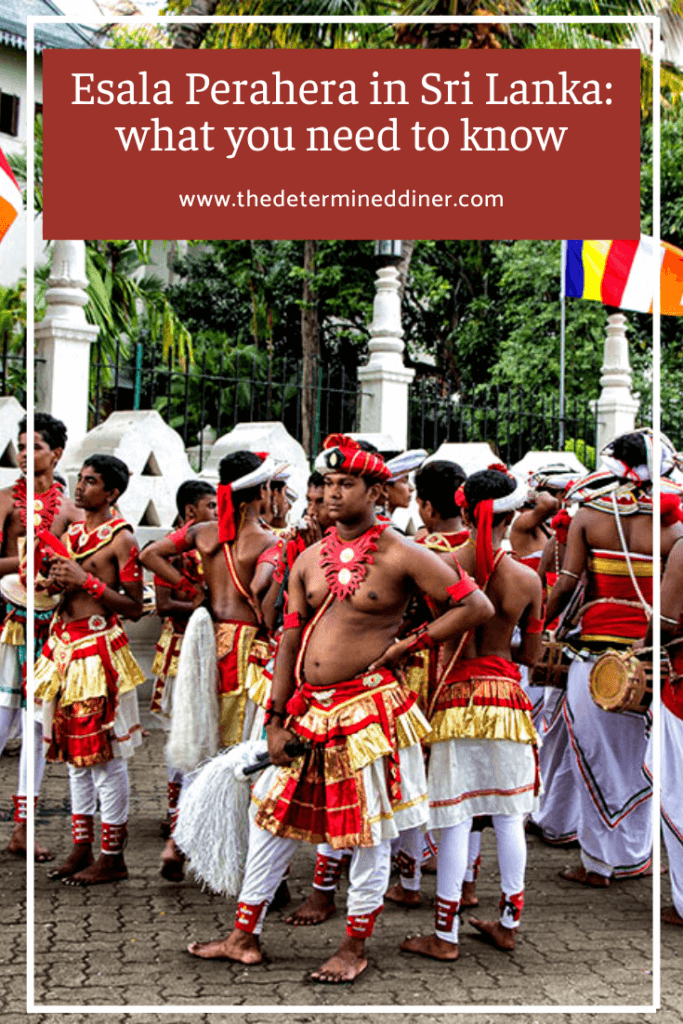
You May Also Like
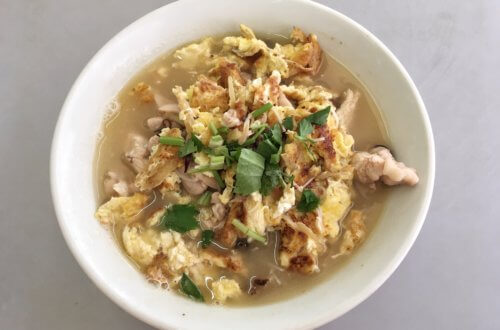
Six must-eat dishes on Jalan Alor
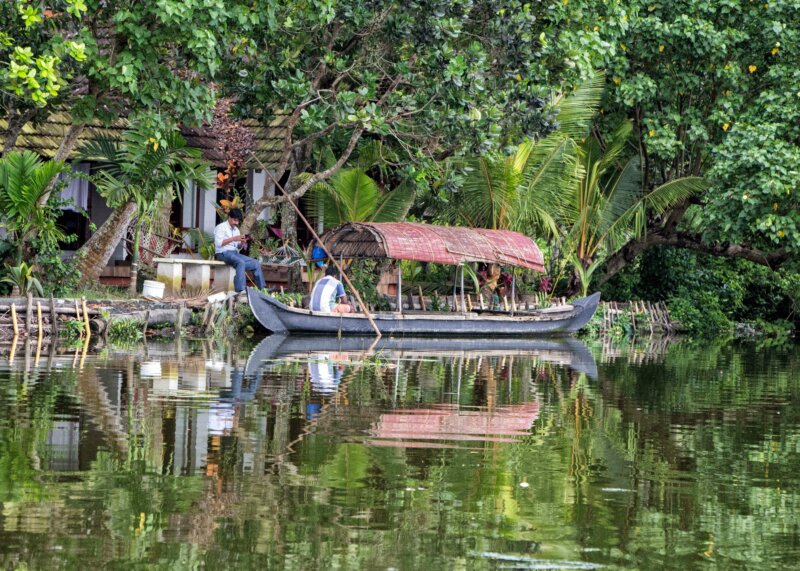
A houseboat in Kerala: How to relax like a pro
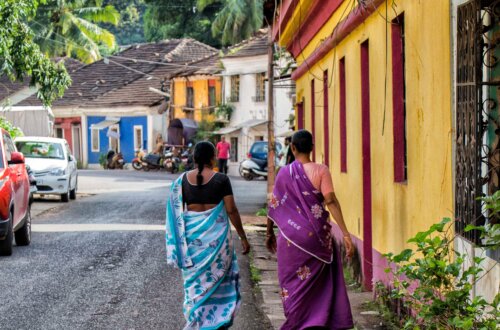
10 colourful photos that’ll make you want to visit Panaji
Privacy overview.
Search form
- Marriage Proposals

- News Features
Sunday, 10 Sep 2023
- Junior Observer
- Youth Observer
The Kandy Esala Perahera
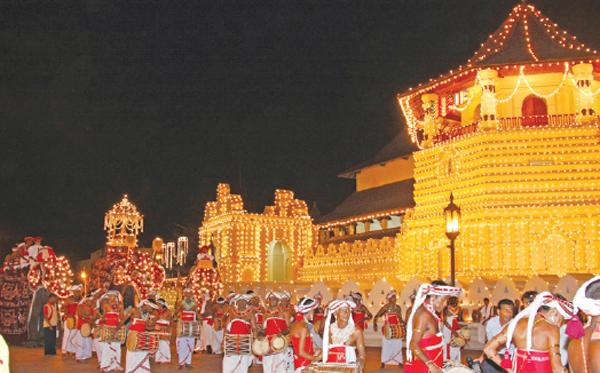
It is considered as the epitome of the country’s Buddhist celebrations. The Sacred Tooth Relic was brought to Sri Lanka due to continuous conflicts in the kingdom of Kaalinga. Princess Hemamala and Prince Dhantha brought the Sacred Tooth Relic to Sri Lanka during the reign of King Keerthi Sri Meghavarna, seeking protection for the Tooth Relic.
During the past eight kingdoms the annual Dalada Perahera was performed to showcase the guardianship of the Sacred Tooth Relic along with all rituals and poojas. The Dalada Perahera is held annually to pay homage to the Sacred Tooth Relic along with numerous rituals and performances.
The procession is composed of musicians, dancers, singers, acrobats, flag bearers and various other performers accompanied by a large number of caparisoned tuskers and elephants. The parading of the streets begins with the whip crackers announcing the commencement of the event.
They are followed by the flag bearers who carry the flags of the different provinces in Sri Lanka. The most exciting experience is watching the performances of drummers and the elephants marching. A herd of elephants are adorned with colourful costumes and taken across the road by mahouts. And also there’s one special tusker which participate as the main casket bearer of the Kandy Esala Peraher. In the past, there were many special tuskers who carried the tooth relic in the procession such as Raja, Heiyanthudawe Raja, Millangoda Raja and Nadungamuwe Raja.
The Kandy Esala Perahera is a mixture of histories and cultures, including Sinhalese traditions, Hindu culture. This is considered to be one of the oldest and cultural events in the world.
Chithsara Dahanayake
Rajapaksa College, Homagama
There are 0 Comments
Related articles.
Produced by Lake House . Copyright © 1995 - 2023 The Associated Newspapers of Ceylon Ltd.
- Subscribe Now

Search form
1 200 April 02, 2024
- Law & Order
- Entertainment
Kandy’s Esala perahera and SL’s cultural transition
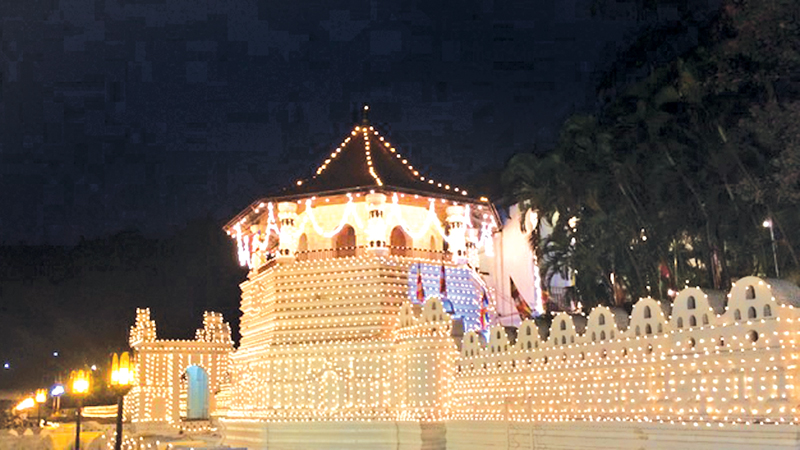
At twilight, a cannon shot screeches through the air. Police on horseback push back the thickening, excited crowds, clearing out the procession route. On the sidewalk, onlookers, who have been waiting for this moment since early morning, picnicking on plastic blankets to secure their coveted spots, suddenly stand up. They forget their shoes and food wrappers on the ground behind them as the sound of beating drums amplifies. A third cannon shot signals the elephants to begin their slow, consequential gait down Kandy’s uncommonly empty streets now glittering under thousands of tiny string lights. It is the final evening of the Randoli Perahera.
“The highlight of Kandy,” says the Secretary to the Lay Custodian of the Sri Dalada Maligawa, Sunil Rambukpotha, of the country’s most important perahera. “The traditions of the perahera have remained largely the same - the colourfulness, the elephants, the dancers, the systems of dances, the musical instruments.”
At the same time, the Kandy Esala perahera is a mixture of histories and cultures, including Sinhalese traditions, Hindu culture, and even Thai influences brought over when the king of then Siam visited during the perahera with a contingent of Buddhist monks. These ethnic variances which make Kandy’s perahera so unique, also reflect the cultural shifts within Sri Lanka and how the perahera has changed with the country.
In fact, the very practice of Kandy’s perahera is a combination of, primarily, two peraheras. The Esala peraherapre-dated the arrival of the Sacred Tooth Relic in Kandy, when farmers paid homage to the gods for rainfall during the month of Esala on the Sinhala calendar. Later, after the Sacred Tooth Relic was brought to the city in the 16th century, the Esala perahera came to include the Dalada perahera.
During the 18th century, the Sacred Tooth Relic was brought out of the Temple in its casket for all of Kandy to pay obeisance, simultaneously transforming the festival into a show of dancers, flame throwers, whip crackers, and tides of majestically dressed elephants. Legend has it that when this tradition started, the monsoons came on time.
“The rains started flowing, the rivers filled up, and Sri Lanka became agriculturally self-sufficient,” said Rambukpotha.
During colonial times, the British changed a key aspect of the perahera by creating the institution of a Diyawadana Nilame, the Lay Custodian of the Temple of the Tooth. The Lay Custodian is an honorary title that is given not to a monk or a king, but rather a member of the aristocracy. He is elected by the Buddhist clergy to help protect the Sacred Tooth Relic and organise Kandy’s annual perahera. Rambukpotha said that during the recent war, security was tightened more and more, until finally crowds diminished dramatically.
“I’ve been watching this perahera since I was a child, in the 1960s, and I would say that there is a decline in the crowds, the number of people who watch the perahera today,” said Rambukpotha. He clarifies that this is his feeling and is not based on any formal research. He thinks the decline in crowds is particularly odd today, given the facilities that are available now. Despite the facilities, he says, the first five days of the perahera attract only small crowds. “In the ’60s and ’70s, people came without any facilities.” Rambukpotha remembers the crowds coming to watch the perahera, due, he speculates, to their faith-based enthusiasm for the festival.
Who comes to Kandy’s perahera today?
On the final two days of the perahera, there are many tourists from abroad, including Buddhist tourists from countries like Japan and Myanmar.
“I like the festival, and also, we are Buddhists,” said Junesakai, a Japanese woman with her friends and relatives, who explained that they had come to the perahera, “not so much as a pilgrimage, but for something like religious tourism.” She remarked upon the fabulous dancing she saw and the wonder of the elephants. Junesakai said that there is nothing like the Kandy Esala perahera in Japan.
Two monks from Myanmar echoed Junesakai’s sentiments, saying that they hadn’t experienced anything like the perahera in their predominantly Buddhist country either. “Other Buddhist countries are different. It’s very interesting,” said 30-year-old Sundaranyana. These monks had made the journey from Myanmar to be at the perahera specifically because of the Sacred Tooth Relic. Being near the Buddha in this way, said Sundaranyana, “is very important in a Buddhist’s life.”
Others, like a group of three young women from England and Scotland, came to be at the perahera serendipitously: “We didn’t know about the perahera, we just stumbled upon it. It’s cool! Amazing,” they said.
Still more came from Sri Lankan cities. Like 36-year-old Sandaruwan who came from Colombo. “It’s our tradition,” he said, explaining that he had come, “to protect this place, and of course the perahera, because of course, this perahera is a mirror of our proud history.”
The perahera attracted Sri Lankans near and far, even members of the Sri Lankan diaspora, like 32-year-old Guri, who lives in New York, but visits Kandy regularly. She says, “I like to be here for the perahera. This is a very important tradition for the Sri Lankan people.”
And yet, speaking with the Daily News, none of these onlookers could explain the perahera’s rich symbolism or historical significance. A fact which may be best summed up by 17-year-old Kavisha from Kalutara, who said that the perahera “means our religious culture.” Elephants, she mused, “symbolise our Buddhist culture.”
Old traditions in a modern world
Today, one of the challenges that the Diyawadana Nilame (Lay Custodian) Pradeep Nilanga Dela faces is to make ancient rituals relevant. “We want to update our standards from the ancient times,” said the Diyawadana Nilame. His private secretary also credits the Diyawadana Nilame with having streamlined the perahera’s logistics.
Yet another way that the Diyawadana Nilame has sought to keep these ancient traditions within the modern context is by offering further education for the perahera’s dancers. “I have decided to start an academy for the dancers,” he says. The academy will reside within the Sri Lanka International Buddhist Academy in Pallekele. “In that academy we will offer diploma courses, then allow them to sit for the degree.” The Diyawadana Nilame guesses that at present only 10-15 percent of the dancers have formal degrees because traditionally, the dancers were part of a rigid caste system that steered them away from formal education.
Another obstacle that today’s Diyawadana Nilame faces is confronting contemporary challenges to old traditions such as the use of elephants at the perahera.
The Diyawadana Nilame is himself an elephant owner, and his personal experiences with elephants makes him extremely sceptical of the contemporary criticisms launched at the ritual.
“Now Western countries are criticising us about the treatment of elephants. But a lot of NGOs are making money off this issue,” he said. The Diyawadana Nilame also argued that British colonisers came to Sri Lanka and hunted elephants.
He said this in explanation as to why outsiders should have no say in the treatment of elephants in Sri Lanka. “In ancient times, there were more elephants, and to use them is our culture, our tradition. We want to preserve it.”
Instead, he laments, “We need more elephants.” Even though, of the less than 100 elephants in captivity in Sri Lanka, every year about 80 percent are used in the Kandy perahera.
Kandy’s perahera in transition
On the final evening of festivities, the Randoli perahera, a captive audience was packed person to person and pressed against the iron bars surrounding the Temple. Behind them, a white building sits unobtrusively over the Kandy Lake, where the queens of the Kandyan Kingdom once watched the perahera from their balcony.
Randoli is translated as ‘queen’s palanquin’. In the Kandyan Kingdom, queens in their palanquins were carried alongside the elephants in the perahera, until 1775, (according to M.B. Dassanayake’s The Kandy Esala Perahera), when King Kirthi Sri Rajasinghe decreed that palanquins should be put at the end of the perahera, because women “could not be permitted to travel alongside the Sacred Tooth Relic.”
It is yet another example of how the perahera has historically adapted to the social context in which it exists. Despite its historicity and prominence, which makes the Kandy Esala perahera a singular event in the country, old traditions and culture tend to accommodate the present moment.
As foreigners and Sri Lankan nationals alike pressed their faces between the bars of the Temple fence, waiting eagerly for the procession of elephants, dancers, and finally the Sacred Tooth Relic to come down the road, it seemed like another moment of transition was in store for the perahera.
Add new comment
Related articles.
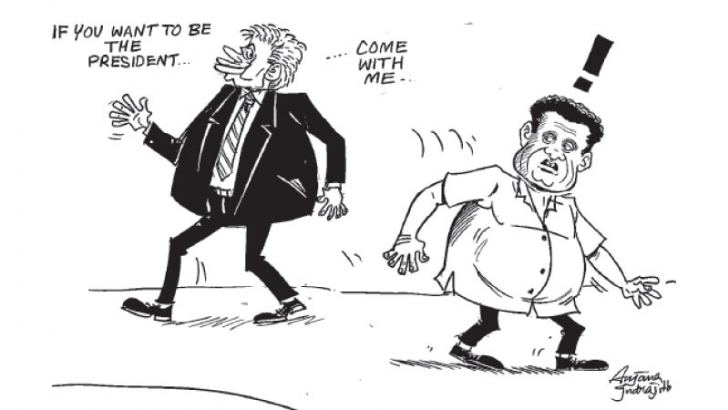
The Delight of the Charming Kandy Esala Perahera!

It is no secret that Sri Lanka is a splendid island that amazes any who visits it. Let it be the spectacular landscapes, pleasant weather and climate , the grandeur of history , cultural heritage , food culture , and yes, the list goes on! However, apart from all these things, there is one more aspect of this beautiful land that offers anyone with a series of memories to cherish a lifetime. Of course, it is none other than the delightful festival celebrations in Sri Lanka . To be specific, Sri Lanka is a land of wonderful festivals. Whether it is Vesak , Poson , Christmas , Ramadan , Maha Shivaratri , or any other festival, all of them hold a unique value, and an exceptional sense of beauty. Besides, the exclusivity, and the delight of the Kandy Esala Perahera stands out from the rest. Hence, we thought of sharing with you its fascination through this read!
What is Kandy Esala Perahera?
Kandy Esala Perahera is the grandest and the most important festival that honours the Tooth Relic of Lord Buddha. In fact, according to the Buddhists, the tooth relic of Lord Buddha is his living evidence. Thus, they respect it and pay homage to it with much devoutness throughout their lives. Accordingly, a number of rituals, especially ‘Poojas’ daily take place at the Temple of Tooth Relic in Kandy , which houses this valuable treasure. However, out of these, the Kandy Esala Perahera is the most significant. Also, this is the most ancient Buddhist festival of Sri Lanka. Besides, it is indeed a highlight, revealing to the world the grandeur of the cultural heritage of this beautiful island.
Besides, paying tribute to the four guardian gods, Natha, Vishnu, Kataragama, and Goddess Pattini is also another motive of this fascinating celebration. In fact, there is a belief that this Esala Perahera has the power of attracting their blessings on the country to obtain timely rain for the cultivation of crops, and to enrich the lands of the ancient Kingdom of Kandy. Thus, apart from honouring the tooth relic and the deities, yearning blessings on behalf of the country, has also been a main reason behind celebrating this wonderful festival.
When is Kandy Esala Perahera?
Esala Perahera festival takes place in the month of July or August . That is parallel to the Esala Full Moon Poya day, which commemorates the first teaching of Buddha after enlightenment. Probably, the Kandy Esala perahera celebration lasts for ten days with a number of interrelated rituals and festivals.
Where is Kandy Esala Perahera?
Unlike many of the other festivals in Sri Lanka, this is not an event that is celebrated across the island. Being a procession festival, it only traverses around the streets of the sacred city of Kandy. Of course, this festival has been a major reason for attracting a high number of tourists towards this city. Thousands of visitors in Kandy during the months of July and August simply prove this fact.
Accordingly, this festival indeed has become a vital factor that impacts the tourism industry of the country . It is true that Kandy has always been a favourite destination of visitors owing to its relaxing climate, spectacular surroundings, and the historical and cultural heritage. However, the delight of this wonderful procession festival further enhances the importance that this city already holds.
The Origin of Kandy Esala Perahera
Of course, there is nothing wrong in mentioning that the exact history of the Kandy Esala Perahera is a mystery. Still, the legends that reveal the history of the country, and the certain books of the popular Chinese Pilgrim ‘Fa Hien’, reveals certain facts about the presence of this wonderful festival even then.
Accordingly, it was during the 3rd century BC that Sri Lanka got this tooth relic. Further, it was during the era of Keerti Sri Raja Singhe (1747-1780) that this pageant celebration began. As per the historical records, centuries back, the relic had been taken around the sacred city of Anuradhapura once a year. However, following the colonization of the island , a number of interruptions have come along the way impacting the continuity of this procession. However, the rituals continued, and the history reveals that the efforts of Upali Thera are significant when considering the history of this festival.
Besides, after the fall of the Kingdom of Kandy in 1815, following the British invasion, the custody of the Tooth relic was handed over to the Buddhist clergy. The absence of the king was observed and then Diyawadana Nilame was appointed to handle the daily routine administrative matters at the Temple of tooth relic.Thenceforth, the person who is appointed as ‘Diyawadana Nilame’ held the responsibility of the tooth relic, and the rituals performed, and this tradition still remains the same even in the present.
Who Organizes the Kandy Esala Perahera at Present?
The Diyawadana Nilame of the Temple of Tooth Relic is the main responsible person who oversees the organizing procedure of the festival. Apart from that, the monks of the M alwatte chapter and Asgiriya Chapter of the buddhist clergy who perform the daily rituals on behalf of the tooth relic, as well as many other officials hold various ceremonial duties related to the festivities.
According to the traditions, the person who bears the position of ‘Nekath Mohottala’ who advises on astrological matters, sets the auspicious times for the festivities. Next, the dates and the auspicious times of the festivals are announced, and the real organizing process begins. Accordingly, the officials contact the traditional drummers, dancing troops, the other performing teams, the elephant owners, etc. and inform them about the proceedings, and the types of performances that they should get ready for.
How is Kandy Esala Perahera Celebrated?
In celebrating this colourful festival, the sacred tooth relic of the Lord Buddha is carried through the kandy streets with much festivity. In brief, it is more like a pageant with a number of alluring events, and the bond that rhythm, colours, light, and dance have with this grand celebration is indeed significant. A number of traditional dancing troops, singing groups, drummers, jugglers, fire-breathers, musicians and lavishly decorated elephants join this procession, coloring the streets with wonderful shades, and illumination. From the past, up to now, this astounding delight of this festival has never got any less, and this beautiful procession still remains as the main feature of this wonderful ritual. Owing to this reason the Kandy esala perahera happens to be one of the most beautiful pageants in Asia.
The Procession of Kandy Esala Perahera
The Kandy Esala Perahera consists of a number of processions, and several wonderful features. To be specific, it consists of five processions of which four are dedicated to the four shrines of Hindu Gods and the Goddesses, namely the Shrine of God Natha, The Shrine of God Maha Vishnu, The Shrine of God Katharagama and finally the Shrine of Goddess Pattini.
However, the Kandy Esala perahera begins with the ‘Sap Sitveema of Kappa’, where they cut the sanctified young Jackfruit and plant it in the premises of each of the for devalayas dedicated to the guardian gods Natha, Vishnu, Kataragama and the Goddess Pattini. These processions are traditionally meant to yearn the blessing on the king and the people of the country in the past, and now to bless the country as a whole.
The Perahera of the Temple of Tooth Relic
By now, you clearly know that the Procession of Kandy Esala perahera has various features, and yes, it is a process of a long time that comes into action on that night. At dusk, on the day of the Perahera festival, at around 8 p.m. to be exact, the Perahera of the Temple of the Tooth Relic, takes the lead and joins with the four processions of the hindu shrines.
The second in the parade is the procession from the shrine of God Natha. Next in line is the procession from the Shrine of God Vishnu at the Maha devale. The fourth procession is from the Kataragam Devale, which is dedicated to the God of Skanda from Kataragama. Of course, all these processions are dazzling and alluring, yet the fourth procession has some unique highlights such as the Kavadi, and Peacock dance, where the pilgrim dancers carry semicircular wooden contraptions with a collection of peacock feathers on their shoulders. Then the final procession is from the Shrine of goddess Pattini, which is located in the west of Natha devale.
Other Festivities of Kandy Esala Perahera
As you might already know, the Kandy esala perahera is a collection of so many features and festivities celebrated within that season. Some of the festivities that take place in connection with this grand procession are as follows.
- Kumbal Perahera
- Randoli Perahera
- Devala Perahera
- Diya Kapeema and Day Perahera
Of course, you might be wondering what these festivities are. Take it easy, because the following sections will enlighten you with regard!
The Kumbal Perahera
Setting the start of the festive season of Kandy, the ‘Devale Peraheras’ from the four shrines mentioned earlier, takes place. The priest of each Devale plays the main role of these festivals, and these processions are held for five nights. These parades also comprise music, and drumming events along with canopy beares, spearmen and flag bearers. However, on the sixth night of the festivities, begins the Kumbal Perahera, and it continues for five days.
The Randoli Perahera
This parade begins upon completion of the five nights of the Kumbal perahera. The word ‘Randoli’ means the planquins on which the queens travelled in the past. However, following the Kumbal Perahera, five Randoli Peraheras take place, out of which the final one is the grandest. And yes, it is the significant attraction which is famous as the ‘Kandy Esala Perahera’, and some of its highlighting features are as follows.
Whip Crackers
It is the whip crackers that set the start of the procession. As the sounds of the crack the whips spread around, the audience gets to know that the procession is nearby. Thus, they are more like the messengers of this grand procession.
Flag bearers
One might not imagine the beauty the flag bearers add to the procession. Still, how they carry the Buddhist flags, and many other flags of the different provinces or temples in lines, is simply a wonderful sight to see.
Another attraction of these processions are the brilliantly draped, and illuminated tuskers. The person bearing the position of ‘Peramune Rala’ rides the first elephant, and then there are few more tuskers taking part in this wonderful parade. However, the tusker who carries the register of the sacred temple of the tooth is the highlight of the procession. Besides, how these giants walk majestically, stepping to the rhythms of the drummers, is indeed delightful to observe. Moreover, the grandeur they bring to this procession is simply indescribable. Also, not every tusker gets the chance of taking part in this parade. There are certain groups of tuskers, selected to take part in this parade. They arrive at the temple a few days earlier to take part in this most honourable festival of Buddhists.
Traditional Drummers and Flute Players
Of course, it is these drummers that add the feet-tapping beats to this elegant parade. Moreover, it is the flute players that add the melodious harmonies to this wonderful festival. The drummers play an array of traditional drums. Besides, the rhythmical movements they follow meanwhile, further enhances the fascination that they create.
Two long chains of vibrant dancers follow the tuskers. Besides, there are many other troops of dancers, in several parts of the parade as well. Most of them are traditional dancers who take part in this procession from generations. How they blend with the traditional drummers in bringing out the splendours of their art, is simply amazing. Moreover, these dancing troops represent various Sri Lankan traditional dancing styles. Thus, this event is also significant as it creates opportunities to pass these genres to the next generations. However, the leaps and the fascinating movements of these traditional dancers are certainly magical. Further, the glamour they add to the Kandy Esala Perahera is indeed impressive.
Diyawadana Nilame and the Officials
Diyawadana Nilame holds the custody of the Tooth Relic. Thus, the role he plays in overlooking the protection and rituals of the tooth relic, organizing festivals related to the temple of the tooth relic, and above all, overlooking every aspect of the Perahera celebration is indeed immense. Hence, he holds a special place in this parade. Accordingly, Diyawadana Nilame, together with his officials, who dress in the traditional regalia of the high officials of kings of the medieval Kingdom of Kandy , walk with pride in this parade.
Diya Kapeema and the Day Perahera
Following the five Randoli Perahera festivals are the rituals ‘Diya Kapeema’ and the Day Perahera. In brief, ‘Diya Kapeema’ is a ritual that has a close connection with water. Moreover, it annually takes place at the Mahaweli River at Gatambe, which is a few miles away from Kandy. Following this ritual, is the Day Perahera. It is a less glamorous festival, which is more like a ritual. Yet, it is important as it solemnly marks the end of the Esala Perahera festivities.
Perahera Sandeshaya
After all the festivities of the Esala Perahaera concludes, a document that states the successful completion of the festivities is handed over to the president of Sri Lanka. Yes, this ritual is known as the ‘Perahera Sandeshaya’. The president accepts the ‘Perahera Sandeshaya’ at the President’s pavilion. The Diyawadana Nilame, Nilames of the four shrines, and some other Nilames from shrines in rural areas join this function.
Schedule of the Kandy Esala Perahera 2021
The Kandy Esala perahera 2021 is to be held abiding by the health and safety guidelines, imposed due to Covid-19. It begins on Saturday, the 13th August, 2021 and ends on Tuesday, the 23rd August 2021. The following table would provide you a detailed schedule of the festivities that last for ten days.
The Bottom Line
All these facts prove to you again and again that the procession of the Kandy Esala Perahera is a festival like no other. In fact, how it shades the beautiful city of Kandy, with a colorful wave of brilliance is simply impressive. Besides, the historical grandeur, and the unique cultural values it exhibits are second none. Moreover, how the charm of these celebrations couple with the solemn of the most honoured Buddhist values are simply delightful. So, there is no wonder in having a huge audience of locals and tourists to witness this elegant parade that has the superpower of alluring any. Thus, if you are ever visiting this splendid island of Sri Lanka, why miss this dazzling celebration? Yes, plan your next trip to this paradise to witness the delight of this wonderful celebration, and it would certainly be a decision that you never regret. Happy and Safe Travelling!
You may be excited for a tranquil beach vacation along a gorgeous stretch of golden sand. If not, you might be thrilled to experience the exhilaration and thrill of the incredible wildlife among the breathtaking scenery. Going further, you can even be anticipating learning about the splendor of the historical tales entwined with the island's customs. Similarly, your dream could be anywhere in these boundaries or outside of them. Nevertheless, we cherish your dream and pledge to turn it into a reality. Indeed, the Customized Tour Packages we provide serve as evidence that we honor our commitments.
Lead Traveler
- Pingback: Dances of Sri Lanka | Culture
- Pingback: Music of Sri Lanka | Culture
Leave a Reply Cancel reply
Your email address will not be published. Required fields are marked *
Save my name, email, and website in this browser for the next time I comment.
This site uses Akismet to reduce spam. Learn how your comment data is processed .
Continue reading...

The Most Exciting Water Sports in Sri Lanka!
Being a beautiful island surrounded by blue water, Sri Lanka is an ideal location for a variety of water sports. If you are an expert,…

Snorkeling in Sri Lanka, A Dive into an Amazing World Underwater!
Blessed with the title “Pearl of the Indian Ocean”, and well recognized around the globe as magical paradise, Sri Lanka is a host to a…
Privacy Overview
- Places To See
- Things To Do
- Plan Your Trip
- List with Us
- Holiday Types
- Travel Guide
- About Sri lanka
© Discover Sri Lanka 2024

- Kandy Esala Perahera
Silverwingslanka.wordpress.com - SILVER WINGS TOURS SRI LANKA
- You are in…
- Destinations
The Kandy Dala Perahera is considered to be one of the most beautiful cultural events in Asia. The celebration is intended to honor the Sacred Tooth Relic and the found main guardian gods, Natha, Vishnu, Kataragama and Pattini. The colourful event consists of various types of dancers, drummers, fire-dancers, whip-dancers, and beautifully dressed elephants. The festival has three major processions, Kumbal Perahera, Randoli Perahera and Diya Kapeema (Water Cutting Ceremony) at the Mahaweli River at Getambe temple. The festival is a unique identity of Sri Lanka and a must see event.
The history of Esala Perahera dates back to the 3rd-century BC, first it was a ritual to honor the gods and seek protection and rainfalls for cultivations. It was then transformed into the current Dalada PErahera in the 4th-Century to honor the Sacred Tooth Relic and the guardian gods of Buddhism.
The perahera starts with a ceremony called Kap Sitaweema or Kappa where four sanctified young Jackfruit trees were cut and planted in the premises of the found shires of gods Natha, Vishnu, Kataragama and Pattini. The next five days the “Devale Perahara” takes place within the premises of the four shires. On the sixth day the Kumbal Perahara starts, it continues on for five consecutive days. Each day the Kumbal Perahera starts at an auspicious time. Whip crackers and fireball acrobats clear the road for the parade, followed Buddhist flag bearers, “Peramune Rala” (front official) of the Perahara, Kadyan drummers, dancers, elephants and musicians. A replica of the relic casket placed in a chamber called “Ransivige” was carried by the Maligawa Elephant in the Kumbal Perahera, the Diyawadana Nilame of the temple of tooth follows the elephant with the lay custodians “Basnayake Nilames” of the devalas. An interesting fact is that only the goddess Pattini’s procession includes female dancers.
After five nights of the perahera the Randoli Maha Peraha commence, and goes on for five nights. The pageant ends with a ceremony called “Diya Kapeema” or water cutting ceremony at the Mahaweli rivers at Gatambe.
The whole festival lasts for about sixteen days, and it is considered as the unique identity of Sri Lankan culture. If you are planning to experience make sure to reserve seats to view the perahera, seats at the queens hotel are the best offering views of the Dalada Maligawa. The perahera takes place for about 3 hours, and be prepared to wait even longer.
Places to stay near Kandy

{{ listing.node.Title }}
- {{ listing.node.ViewsText }}
- {{ listing.node.FavsText }}
- {{ listing.node.ThumbsText }}
- {{ listing.node.SharesText }}
Places to eat near Kandy
Things to do near kandy.

IMAGES
COMMENTS
Kandy Perahera English essay. Kandy Perahera comes in March. It is very interesting. A lot of people visit Kandy to see the Perahera. Many elephants walk in the Perahera. 'The Maligawa elephant' is the most beautiful. It takes the casket of tooth -the tooth of Lord Buddha. The Kandyan dancers go in front. Elephants come after them.
Perahera Tuskers in front of Temple of the Tooth. The Kandy Esala Perahera (the Sri Dalada Perahara procession of Kandy) also known as The Festival of the Tooth is a festival held in July and August in Kandy, Sri Lanka.This historical procession is held annually to pay homage to the Sacred Tooth Relic of Buddha housed at the Sri Dalada Maligawa in Kandy. A unique symbol of Sri Lanka, the ...
It is our duty to understand the value of the historic Dalada Perahera and hand it over to the next generation. This Essay has 218 words. Total number of words to be = 200. Total Marks = 14. Sinhala essay :- The Kandy Esala Perahera/ Kandy Dalada Pereahera - Grade 8.
This video includes information on Kandy Esala Perahera. It will be useful for students in grade 4 and 5. You can also use this as a speech or an essay.The E...
The Kandy Perahera in Sri Lanka is not only one of the oldest rituals in Buddhism, but one of the oldest extant rituals in all of Asia. "Perahera" means procession. Processional music and dancing is a marker of antiquity because some of the earliest ritual processions grew from stationary artists starting to move. It follows that dance ...
The Esala Perahera is a ten-day event that typically takes place during the months of July or August, with the specific dates being determined by the lunar calendar. The festival is divided into two main parts: the Kumbal Perahera and the Randoli Perahera. The first five days consist of the Kumbal Perahera, which is relatively simple.
A few days before the Esala Perahera, A Kapa, a sapling from a tree that sheds milky juice is erected in each of the four Devales. On the 5th day, The Kumbal Perahera begins and goes on for 10 consecutive nights when the sacred relic casket is taken around the streets of Kandy accompanied by exotically costumed dancers and drummers.
Grandeur and Scale of the Parade. The Esala Perahera festival in Kandy, Sri Lanka, is known for its grandeur and scale.The procession features majestic elephants adorned in ornate regalia, accompanied by dancers, drummers, and traditional musicians.. It's a mesmerizing display of vibrant colors and electrifying performances that create an unforgettable atmosphere.
Esala Perahera in 2020. Unlike in the past, this year the Kandy Esala Perahera does not allow public participation due to preventive measures employed to subdue the Covid -19 pandemic. The number of elephants and artists who would take part in the festival are also reduced. But the essence of the festival is in no way dampened.
The Kandy Esala Perahera is a vibrant religious procession that takes place during the month of Esala (July/August) in Kandy, Sri Lanka. It is dedicated to the Sacred Tooth Relic of Lord Buddha, which is housed in the Temple of the Tooth (Sri Dalada Maligawa) in Kandy. The festival spans over ten days and culminates in the grand finale, known as the Randoli Perahera.
June 25, 2011. The famous Kandy Perahara (Esala Perahara / the festival of the tooth) is one of the most important annual Buddhist celebrations takes place in Sri Lanka and it is also considered as one of the most spectacular religious processions in Asia. Sri Lankans from all over the country and an ever increasing number of foreign visitors ...
The tooth is precisely the reason for the 10-day elaborate multi-procession festival happening in the city this week, Kandy's Esala Perahera, in which a replica of the relic is paraded around ...
The Origins of the Kandy Esala Perahera: The genesis of the Kandy Esala Perahera can be traced back to the 4th century BCE, during the reign of King Kirthi Sri Meghavarna. It is believed that the Perahera, in its early form, was an ancient ritual performed to invoke rainfall and prosperity. Over time, the Perahera became intrinsically linked to ...
The Kandy Esala Perahera is a grand pageant that showcases the island's millennia-old traditions and customs. It represents the legacy of the Dalada Vahansa in Sri Lanka and the great dedication of her people to protect and worship the Sacred Relic. exploresrilanka.lk EXPLORE SRI LANKA | AUGUST 2021.
The Perahera festivities are held each year over eleven consecutive days in August, with ten nightly processions in all. The first five are called "Kumbal Perahera" (kumbal signifying the flight of the potter wasp, which the Perahera is said to resemble), and the remaining five "Randoli" (randoli referring to the jewelry worn by the royal concubines, which in the Kandyan era was ...
The Kandy Esala Perahera. Step into the hill capital of Kandy this August to witness the grand spectacle of the Esala Perahera as it parades the streets in a whirl of colour, culture and pomp ...
Tissa Devendra, in The Island, 3 October 2018, with this title " Mirror of Civilisation" b eing a book review of The Kandy Asala Maha Perahera - by Dr.Lorna Dewaraja (Vijitha Yapa Publications 2018) In publishing this fine book, Vijitha Yapa has faithfully fulfilled the last wish that Dr. Dewaraja expressed to her family - to hand over to Vijitha Yapa the manuscript of her book on the ...
The Esala Perahera is linked to the Buddhist Temple of the Tooth in the Sri Lankan hilltop town of Kandy. The temple holds the sacred Buddha's tooth and, for 10 nights every summer, a grand procession is held to honour this relic. It's one of Sri Lanka's - indeed, Asia's - biggest festivals. So that's why it helps to be at least a ...
The Esala Perahera in Kandy is one of the oldest and grandest religious celebrations of Buddhists in Sri Lanka. The Sacred Tooth Relic is housed in the Sacred Temple of Tooth in the city of Kandy. There are daily, weekly and annual poojas and rituals. The Dalada Perahera is known as the Kandy Esala Perehera and is held in July or August annually.It is considered as the epitome of the country ...
Kandy's perahera in transition. On the final evening of festivities, the Randoli perahera, a captive audience was packed person to person and pressed against the iron bars surrounding the Temple. Behind them, a white building sits unobtrusively over the Kandy Lake, where the queens of the Kandyan Kingdom once watched the perahera from their ...
The Kandy Esala perahera 2021 is to be held abiding by the health and safety guidelines, imposed due to Covid-19. It begins on Saturday, the 13th August, 2021 and ends on Tuesday, the 23rd August 2021. The following table would provide you a detailed schedule of the festivities that last for ten days. Days.
The Kandy Esala Perahera Lake House News. Kandy -- The period July-August (Esala-Nikini in the traditional Sinhalese calendar) is the Esala Perahera season in Sri Lanka.The Sinhalese term 'perahera' means a train of musicians, dancers, acrobats and other performers usually accompanied by a number of elephants parading the streets in celebration of a religious or secular person or event.
The Kandy Dala Perahera is considered to be one of the most beautiful cultural events in Asia. The celebration is intended to honor the Sacred Tooth Relic and the found main guardian gods, Natha, Vishnu, Kataragama and Pattini. The colourful event consists of various types of dancers, drummers, fire-dancers, whip-dancers, and beautifully ...